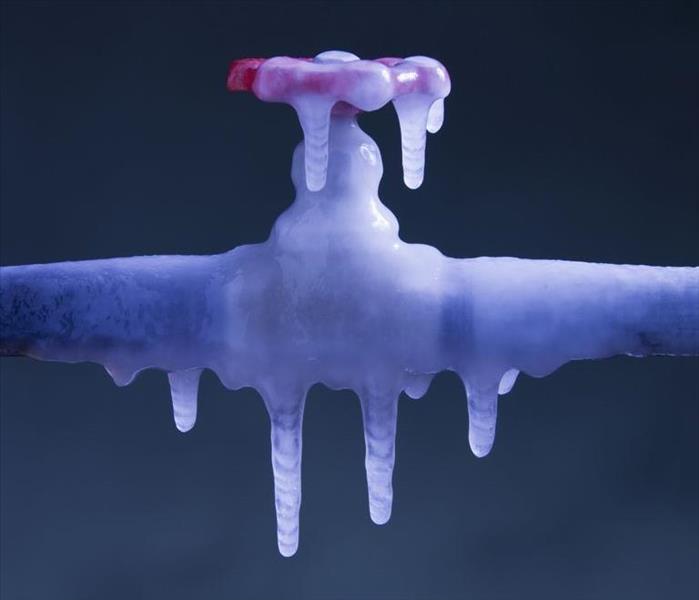Archived Water Damage Blog Posts
What To Do When A Pipe Burst At Home
3/14/2025 (Permalink)
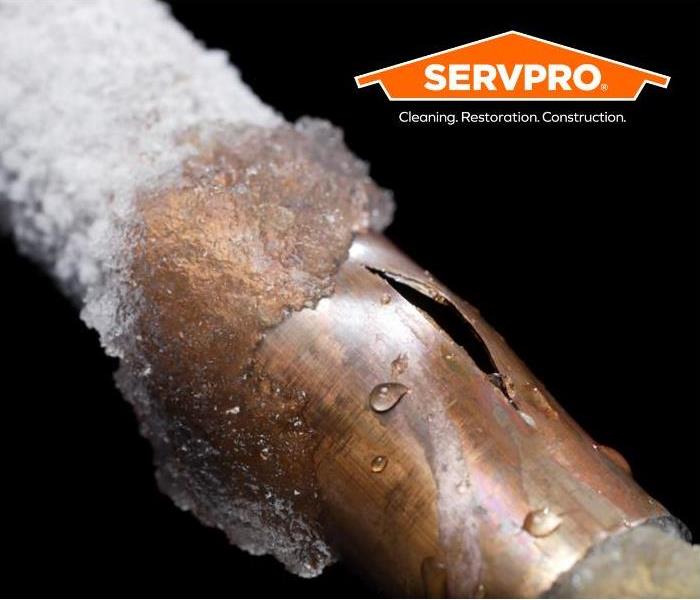 For all your Vancouver water restoration needs call SERVPRO of Vancouver East-West Clark County (360) 254-0049
For all your Vancouver water restoration needs call SERVPRO of Vancouver East-West Clark County (360) 254-0049
A burst pipe can cause significant water damage in your Vancouver home, leaving you stressed and overwhelmed. However, knowing what steps to take can minimize the impact and help you restore your property. Here’s what you need to do when faced with a burst pipe.
Shut off the Water Supply
The first step is to stop the flow of water by turning off the main water valve. This will prevent any further flooding or damage to your property.
Turn off the Electricity
If water has come into contact with electrical outlets or wiring, it’s essential to turn off the electricity on your circuit breaker to avoid the risk of electricity.
Assess the Damage
Take a quick around the affected areas. If it is safe, remove any valuable items or furniture to prevent them from being damaged.
Call SERVPRO of Vancouver East-West Clark County
Water damage can be a complex process. Contact our team as soon as possible as we have the expertise and equipment to efficiently manage the cleanup, drying and restoration process.
Document the Damage
Take photos of the affected areas for insurance purposes. This documentation will be helpful when filing a claim.
When a pipe bursts, acting quickly is crucial to minimizing water damage and preventing long-term issues like mold growth. For effective water damage cleanup and restoration, trust SERVPRO of Vancouver to restore your home quickly and thoroughly “Like it never even happened.”
Spring Showers, Spring Floods: Protecting Your Property with Expert Water Damage Restoration.
3/10/2025 (Permalink)
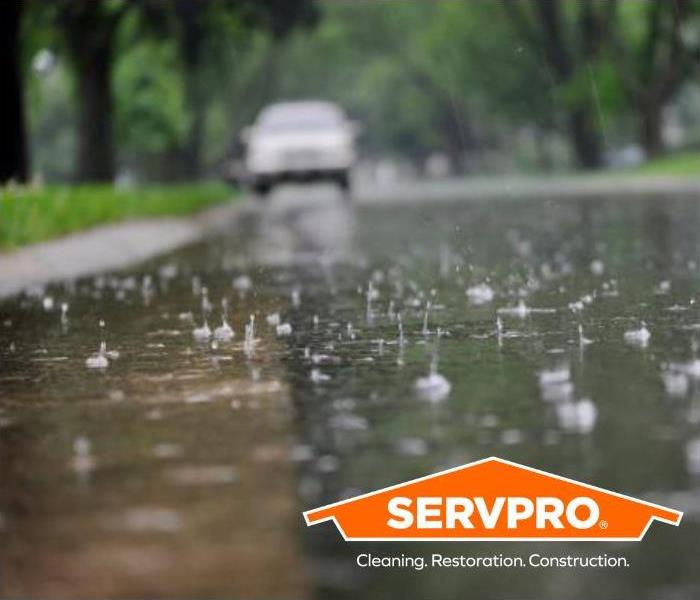 Call SERVPRO OF VANCOUVER EAST-WEST CLARK COUNTY This Spring for All Your Water Damage Restoration Needs (360) 254-0049
Call SERVPRO OF VANCOUVER EAST-WEST CLARK COUNTY This Spring for All Your Water Damage Restoration Needs (360) 254-0049
Spring's arrival brings warmer weather and blooming flowers, but it also signals the start of increased rainfall and potential flooding. After a long winter, melting snow and spring showers can quickly overwhelm drainage systems, leading to unexpected water damage. As the thaw begins, it's crucial to be prepared and understand the importance of prompt water removal, mitigation, and restoration.
Spring's Hidden Dangers:
- Increased Rainfall: Spring showers can be intense, leading to roof leaks and overflowing gutters.
- Melting Snow: Snowmelt can saturate the ground, causing foundation leaks and basement flooding.
- Frozen Pipe Thaws: Pipes that froze during winter can crack and burst as they thaw, causing significant water damage.
- Overflowing Rivers and Streams: Spring runoff can cause rivers and streams to overflow, leading to widespread flooding.
Why Spring Demands Swift Action:
With warmer temperatures, mold growth accelerates. Prompt water removal and mitigation are critical to preventing this. Don't let spring's beauty be overshadowed by water damage.
Our Spring Water Damage Solutions:
- Rapid Response: We understand the urgency of spring water damage and offer 24/7 emergency services.
- Comprehensive Water Removal: Powerful pumps and extraction equipment to eliminate standing water quickly.
- Effective Water Mitigation: We'll address the source of the problem and prevent further damage.
- Thorough Restoration: From drying and sanitization to repairs and reconstruction, we'll restore your property to its pre-damaged condition.
Don't let spring's unpredictable weather catch you off guard. Contact SERVPRO Vancouver East-West Clark County today for expert water damage restoration services and protect your property from the risks of spring flooding.
What to Do When You Discover Water Damage in Your Home
2/21/2025 (Permalink)
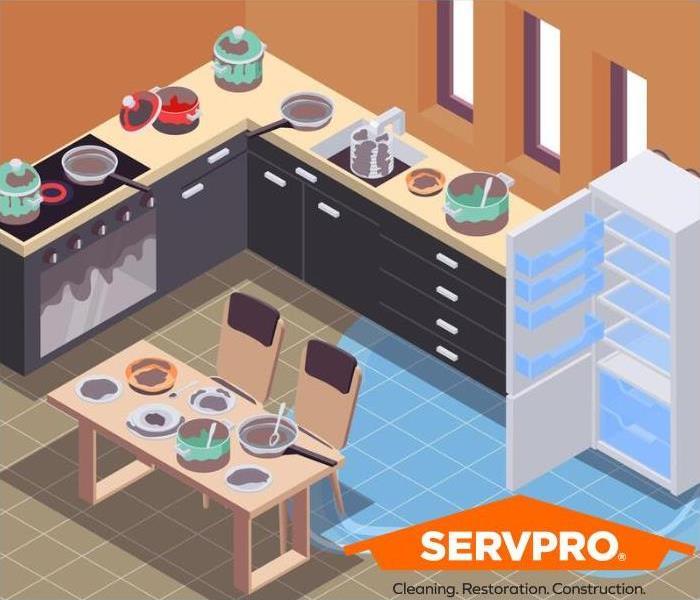 For All Your Water Damage Restoration Needs, Call SERVPRO of E. /W. Vancouver at (360) 254-0049
For All Your Water Damage Restoration Needs, Call SERVPRO of E. /W. Vancouver at (360) 254-0049
Discovering water damage in your home can be stressful. Whether it comes from a burst pipe, a leaky roof or flooding, it is important to act quickly in order to minimize damage and prevent further problems such as mold growth. If you ever experience water damage, here are some immediate steps to take.
Safety First
- If there is an electrical danger nearby, turn off the power at the main breaker.
- Avoid walking through deep water where electrical hazards may be present.
Stop the Source
- If possible, identify the sources of the water damage. This may include turning the water valve off or patching a leak.
Remove Excess Water
- Use towels, mops or a wet vacuum to remove as much excess water as possible.
Documenting the Damages
- Take pictures and videos of the affected areas for insurance purposes.
Call the Professionals
- Contact SERVPRO of E. /W. Vancouver immediately. Prompt action from our professionals can prevent long-term damage.
Water damage can escalate rapidly, so don’t delay. Our team at SERVPRO of E. /W. Vancouver is available 24/7 and is here to provide fast and reliable water restoration services in Vancouver and Clark County.
What is Water Mitigation?
8/29/2023 (Permalink)
Water mitigation refers to the process of reducing or preventing the damage caused by water in a property. This can include water damage caused by floods, leaks, burst pipes, or other sources of water intrusion.
The first step in water mitigation is to identify the source of the water and stop it from entering the property. Once the source has been identified and stopped, the next step is to remove any standing water and dry out the affected areas.
This can involve using specialized equipment such as dehumidifiers, air movers, and moisture meters to ensure that all moisture has been removed from the property. It is important to act quickly in water mitigation to prevent further damage and the growth of mold and mildew.
In addition to drying out the property, water mitigation may also involve repairing any damage caused by the water, such as replacing damaged drywall or flooring.
Overall, water mitigation is an important process for protecting your property from the damaging effects of water. If you experience water damage in your home or business, it is important to contact a professional water mitigation company to help you with the cleanup and restoration process.
Top 3 Things to Throw Out After a Fire
8/29/2023 (Permalink)
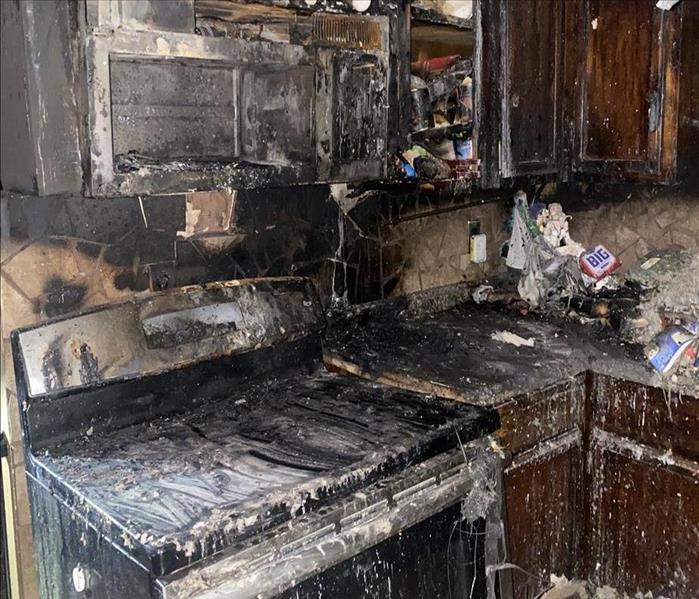 Fire damage left in the aftermath of a residential kitchen fire
Fire damage left in the aftermath of a residential kitchen fire
Items that Need to Be Thrown Out After a Fire
When a fire occurs in your home in Salmon Creek, WA, the process of cleaning up can be daunting. Often, people are unsure of what to throw away. There are several types of items that are often damaged in fires, and they commonly need to be thrown out.
1. Cosmetics
Cosmetics, even if they are packaged, generally need to be stored in clean, cool environments to remain in good condition. Unfortunately, high heat from a fire can cause the packaging of many items, and the items themselves, to melt. As a result, smoke and soot can easily damage the cosmetics, making them unsafe to use.
2. Food
After a fire, it’s often best to throw away the majority of food items in your home. Though some items may be visibly damaged, especially if the fire occurred in the kitchen, some pieces of food may appear to be unharmed. However, even if items are canned or wrapped up, smoke and soot can still affect the quality of food, and consuming food that has been harmed by soot or smoke damage can be hazardous. If you’re unsure whether or not food has been harmed, it’s generally best to discard the item.
3. Medication
Many medications need to be stored in relatively cool environments, and some medications may need to be stored in a refrigerator. During a fire, the temperature in a house can quickly rise. The high heat from a fire can damage the overall quality of the medication, which can ultimately make the medication ineffective and unsafe to consume. If you can document the medications that need to be replaced, you may be able to receive compensation from your insurance company.
Knowing that you may need to throw away cosmetics, food, and medication after a fire can help make the process of sorting through your belongings easier. Often, homeowners whose homes have sustained damage from fires find it useful to work with fire damage restoration experts.
What Causes Water Leaks?
9/1/2022 (Permalink)
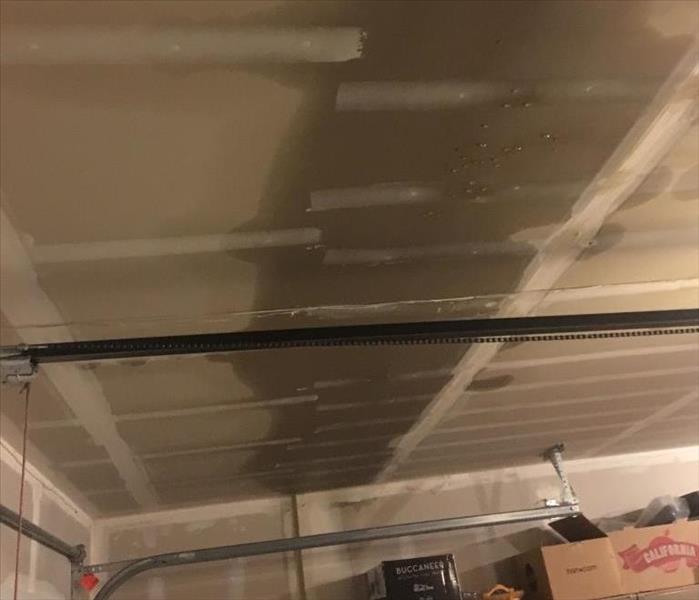 No matter the cause, we're happy to be the solution! Call us day or night (360) 254-0049
No matter the cause, we're happy to be the solution! Call us day or night (360) 254-0049
Water leaks can occur from a number of sources both in and outside of your home. Understanding the cause of water leaks can help you be prepared for the unexpected. By carefully inspecting your home’s plumbing and adjusting the runoff grade around your home, there’s a lot you can do to help keep your home watertight.
Clogged drains and gutters
Trapped water in your gutters can cause the wood fascia boards your gutters are mounted on to rot, allowing moisture to enter your house. Additionally, the clogged debris in your gutters can cause water to sit on top of your roof that could lead to roof leakage. Although you might only consider gutter cleaning necessary once or twice a year, your home can really benefit from a monthly gutter cleaning. By doing so, you can avoid water running over the gutters and pooling next to your foundation.
Rain runoff near foundation
Rainwater can pool and saturate the soil near your foundation and could leak through holes or cracks. Keep rainwater flowing away from your home with downspout extensions. Doing so can help water from infiltrating through foundation cracks and getting into your basement.
Sump pump damage
A blocked drain hose or inlet screen on your sump pump can prevent it from working properly and could lead to a basement flood. A key way to prevent expensive water damage is to be sure that your sump pump is operating correctly. Mark your calendar and inspect your sump pump.
Plumbing lines
Broken seals, corrosion and loose water connections in the plumbing can cause water leaks. By checking in frequently with your home’s plumbing lines, you’ll be better able to locate water leak issues as they surface. Many times, the key to preventing water damage is to catch it early where a nominal repair can save from a major expense.
Damaged roof
Broken or missing shingles, cracked flashing and damaged vent booting are all common culprits that can cause your home’s roof to leak. One way that big water damage issues occur to homes is through the roof. By monitoring and replacing the components of your roof, you’ll help to prevent water damage to your roof that can sometimes go unnoticed. Another key way to keep your roof healthy is to manage ice dams by preventing ice buildup during the winter months.
Untamed vegetation and soil
It’s important to look for any roots from trees or plants that could wrap themselves around your exterior pipes causing damage. To prevent water from pooling near your home’s foundation and leaking in, ramp the soil down and away from the house to help with runoff.
Broken appliances
Home appliances keep your home humming along — they’re also the leading cause of in-home water damage. Check and maintain your appliances regularly, especially washing machines and refrigerators.
-Information provided by American Family Insurance.
Don't Let Leaks Go Undetected
8/18/2022 (Permalink)
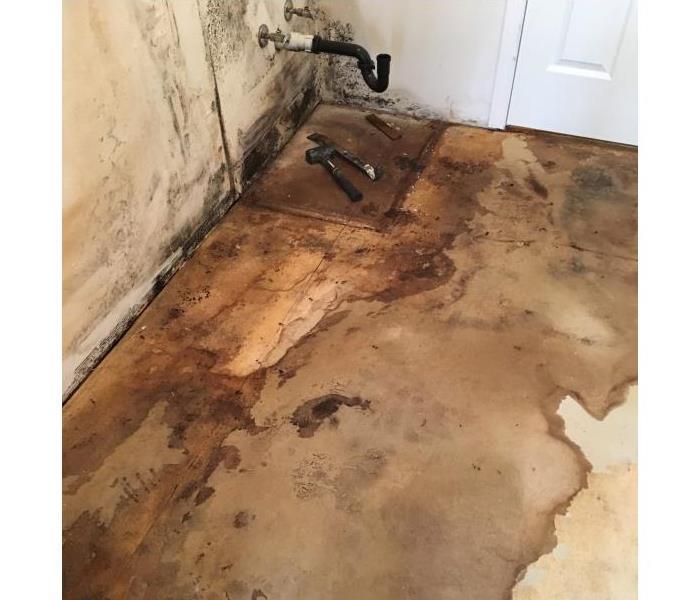 The longer the damage goes undetected, the more severe the damage becomes. Don't delay, call our SERVPRO office (360) 254-0049
The longer the damage goes undetected, the more severe the damage becomes. Don't delay, call our SERVPRO office (360) 254-0049
When it comes to water damage, it is important to remember that it doesn’t take a major flood or a hurricane to cause severe damage to your home. Most water damage problems are actually the result of a small leak that goes undetected over a long period of time. By the time you notice it, it is too late. Your drywall can become swollen and stained, ceilings could be sagging, carpets ruined, floors warped and it could pose a threat to your home’s electrical system.
Whether you’ve discovered water damage from a broken or leaky pipe, a sewer line break, a sink or toilet overflow, or a malfunctioning appliance like a water heater, washing machine, dishwasher or refrigerator in your home, our flood damage technicians are equipped to handle any problem 24 hours a day.
Something as small as above average humidity levels are more than enough to cause you problems, namely in the form of mold, mildew, and other potentially dangerous toxins. According to the CDC you should keep the moisture levels in your inhabitable spaces between 40% to 60%.Molds slowly destroy the things they grow on, and if left unchecked, can cause serious structural damage.
Fast Response
The key to proper restoration is fast response time. The sooner you call SERVPRO the faster our team of certified service technicians can get to work to make the water damage "Like it never even happened."
Our water damage services include:
- Water extraction
- Structural drying
- Damage Assessments
- Mold Remediation
- Antimicrobial treatment
- Debris Removal
- Upholstery & Carpet Cleaning
- Structural Repair
We strive for exceptional customer service.
Our top priorities are safety, quality, and exceptional customer service. We are an emergency restoration company that provides service to both residential and commercial clients. If you have flooding of any kind, our trained and certified technicians can handle any and all water damage situations. We make sure that any affected area is professionally cleaned, deodorized and sanitized. SERVPRO of East Vancouver/ Clark County is available to handle any opportunity 24 hours a day.
Ways to Protect Your Home From Water Damage
8/18/2022 (Permalink)
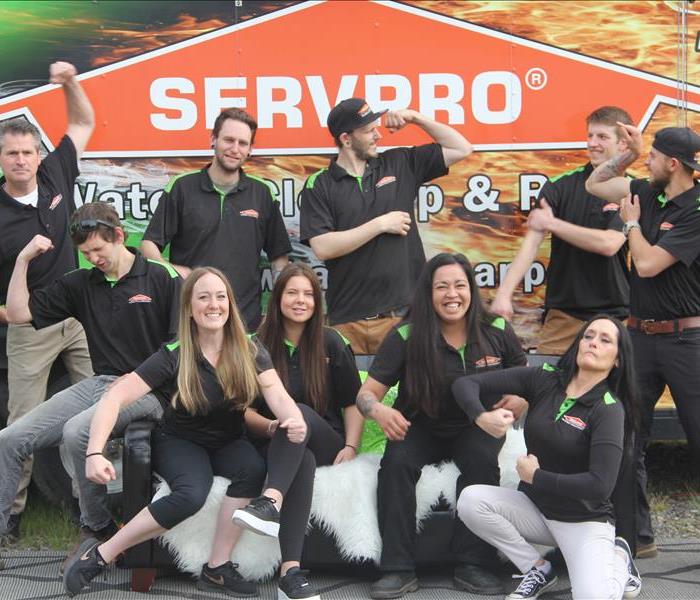 If you do experience a water damage, remember you are SERVPRO strong! We are "Here to help." Just call our 24hr number (360) 254-0049
If you do experience a water damage, remember you are SERVPRO strong! We are "Here to help." Just call our 24hr number (360) 254-0049
One of the best ways to protect a home from water damage is by taking some preventative measures. Keeping up with routine maintenance and making prompt repairs is key.
Remember, homeowners insurance covers water damage that is “sudden and accidental” but not gradual problems or maintenance issues. If you have a problem like a leaky faucet, it’s best to take care of it as soon as possible.
Here are other steps you can take:
- Drain water heaters twice a year to help prevent sediment buildup.
- Install smart water leak detectors that will send an alert to your phone or email. (Some detectors can automatically shut off the water to prevent damage). In a LexisNexis study of 2,306 U.S. homes that installed a Flo by Moen water leak detector, water-related claims went down by 96% compared to the two years prior to installation.
- Inspect hoses going to and from washing machines, dishwashers, water heaters and refrigerators. Repair or replace any damaged hoses if necessary.
- Inspect your roof and make any necessary repairs, such as replacing missing, rotten or damaged shingles. It’s also a good idea to clean out your roof gutters. Clogged gutters can overflow and allow water to pool near a home’s foundation, which could seep into your basement.
- Prevent frozen pipes if you live in an area that has extreme cold temperatures. Keep your heat set to at least 50 degrees and consider other precautions, like wrapping pipes with insulation.
- Remove snow from your roof to prevent potential ice dams. Snow can melt and freeze on roofs and in gutters, causing ice dams, which can lead to damage to both the exterior and interior of homes. A roof rake can help you remove snow from the roof to limit the possibility of snow dams.
- Remove leaves from your gutters each fall to reduce the risk of clogged drains, which can lead to ice dams in the winter.
This information was provided by Forbes Advisor.
Toilet Overflow
5/25/2022 (Permalink)
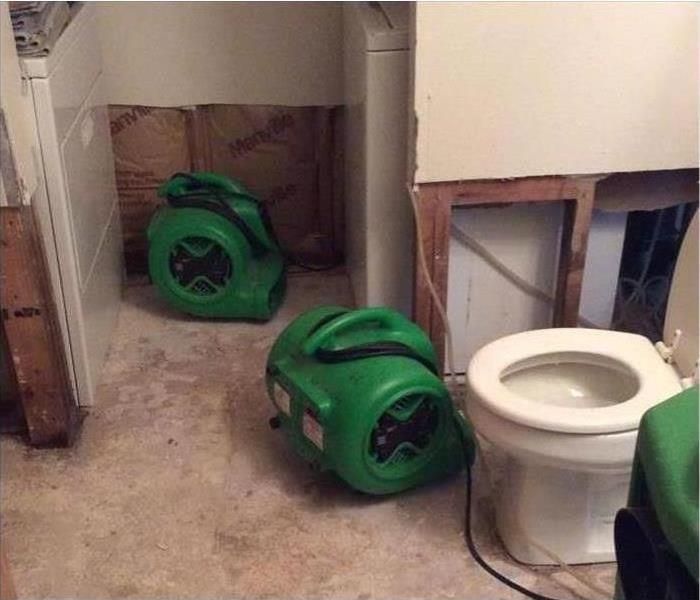 Call our office for assistance (360) 254-0049
Call our office for assistance (360) 254-0049
An overflowing toilet is a frustrating problem, no matter what the circumstances involve. However, when the overflow involves a sewage backup, the problem becomes much more serious. Sewer damage could contain viruses, bacteria, and other illness-carrying microbes. The possible risks associated with contamination could affect your Vancouver, WA, home and your family for many years.
- Toilet Overflow: Blockage in the plumbing system causes the toilet to overflow. In this case, the flooding water hasn't passed through the sewer system. Water damage may occur, but you won't have to involve the sewage company.
- Plumbing System Overflow: Water from the sewage system backs up through residential lateral pipes and into homes. This water is often filled with serious contaminants, such as raw sewage.
If you can't tell whether you have an overflowing toilet or a sewage situation, contact a professional immediately(we're happy to give you a professional recommendation). If you have a flooded toilet, you may be able to handle the problem yourself.
Step 1: Stop Flushing
Much of the time when homeowners see something they don't like in the toilet, they flush. Unfortunately, this will only make a flooded toilet situation worse. Each flush contains more than a gallon of water that you'll have to clean up off the floor.
Step 2: Turn Off the Water
There should be a water shut-off valve located near the floor behind the toilet. Once the water has been shut off, you won't have to worry about more water making the situation worse.
Step 3: Clean Up Spilled Water
If the toilet was only flushed once or twice, you can probably mop it up pretty quickly. If there were more flushes and the resulting four to five gallons of water, you may want to contact a professional to prevent water damage.
Step 4: Address the Clog
Hopefully, you'll be able to dislodge whatever was stuck in the pipes and return to your normal daily activities. Otherwise, you may need to contact a professional.
Remember to protect your home and family from sewer damage. Learn how to recognize the type of trouble you have and take the right steps for correction.
What is a Category Two Water Damage?
4/1/2022 (Permalink)
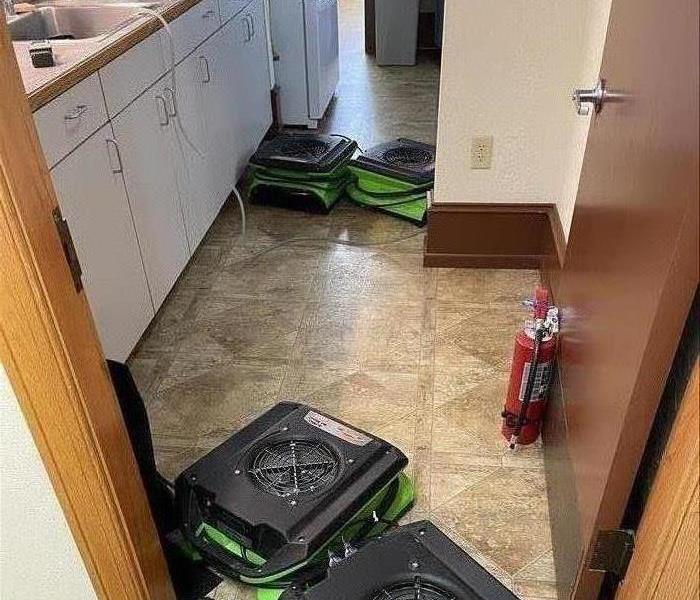 Don't delay, call the leaders in water damage restoration. We're 24/7/365 just call (360) 254-0049
Don't delay, call the leaders in water damage restoration. We're 24/7/365 just call (360) 254-0049
Not all commercial flooding is the same. Typically, your water damage will fall into one of three categories.
• Clean: Category One
• Gray: Category Two
• Black: Category Three
Most people can easily understand categories one and three. Clean water is not contaminated and comes from a broken pipe that carried fresh water. Black water is highly contaminated and often comes from sewer lines. Category two falls somewhere in the middle. Here's what you need to know about this type of flooding.
Picks Up Contaminants
When a water pipe repair flood fits into this category, the water was able to pick up contaminants. This can happen when a pipe bursts on the second floor. Even thought the water starts on the second floor, it often travels through drywall, flooring and other materials to reach the first floor and basement. As the water travels through these sources, it may pick up bacteria, viruses and other contaminants.
Sits Too Long
Clean water that is allowed to sit for long periods of time before the remediation is started can turn into category two. Mold spores may enter the water from the air or the liquid may leach contaminants from its surroundings. If you have a flooded building, you need to call in a commercial restoration team quickly to avoid this change.
From a Contaminated Source
Sometimes the water itself is contaminated when it enters your home or business building. If you're not dealing with a water pipe repair, but instead have a dishwasher or washing machine overflow, the water could already be contaminated. Some toilet overflow may also fit into this category so long as no feces is in the flow.
If you hear that you have category two water damage, you need to know that there may be some contamination. Responding quickly to a water pipe repair can help you solve the problem and may even reduce your chances of dealing with unsavory contaminants.
Commercial Insurance Policy Water Damage Coverage
3/4/2022 (Permalink)
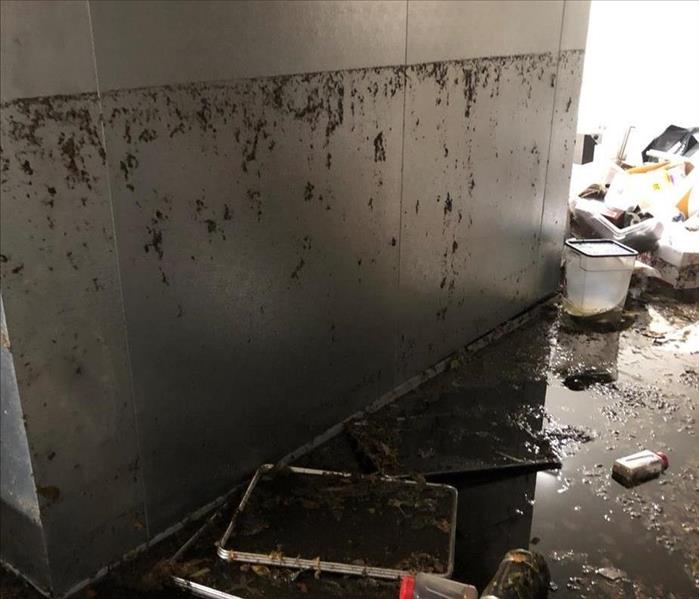 Follow us for more tips on our social media pages!
Follow us for more tips on our social media pages!
Are You Adequately Protected For Potential Water Damage?
Owning a business is a big responsibility. Safeguarding your building, equipment and inventory from water damage and other potentially costly perils may be a top priority. Although taking a proactive approach is often helpful, unforeseen situations can arise. For this reason, it’s important to possess business insurance and understand key provisions of your policy to ensure you are adequately protected.
1. Burst Pipes
Insulating exposed supply lines can prevent frozen and broken pipes during the winter. Most coverage does, however, usually include provisions to cover damage resulting from pipe bursts.
2. Water Leaks
Water leaks can also develop from aging infrastructure and equipment failures. Although it may be difficult to find compromised pipes hidden behind walls, performing routine maintenance on your building’s fire suppression and HVAC systems can help prevent some water damage. While every policy is different, most plans cover leaks and subsequent water cleanup requirements, offering some peace of mind.
3. Overflowing Toilets
While many companies encourage proper waste disposal, clogged and overflowing toilets are another common commercial problem. Because not all policies include sewage damage protection, you should carefully examine your plan. To avoid expensive out-of-pocket sewage cleanup costs, you may need to purchase supplemental coverage.
4. Storm Damage
A strong storm can damage your roof and break windows, allowing destructive water infiltration. Flooding can also occur. While storm damage may be covered, flooding is usually excluded from most business insurance plans. To protect your company’s financial security, you should discuss these topics with an insurance agent who can help you assess your risk and purchase flood insurance.
Water damage can result from a variety of scenarios, some of which may not be covered under many business insurance policies. Because water cleanup and restoration costs can be costly, inadequate coverage can result in significant financial losses. For this reason, it’s crucial for every business owner to analyze their situation and prepare for potentially destructive events.
Water Damage Claim Inventory
1/18/2022 (Permalink)
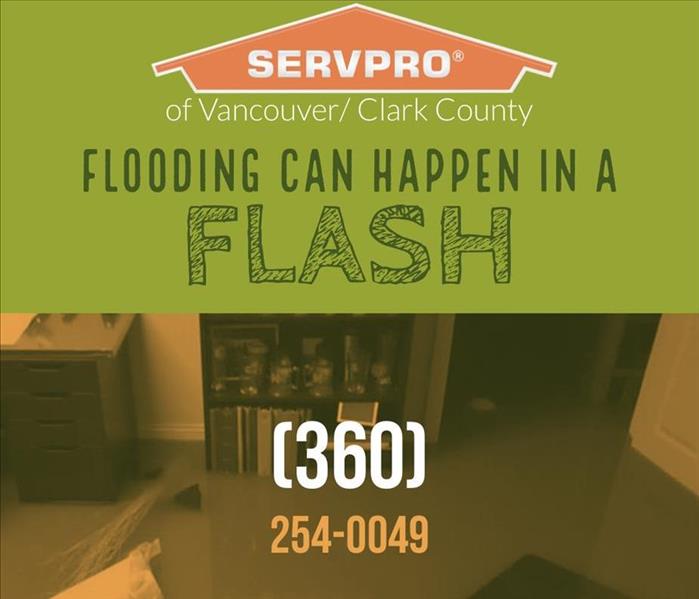 Need help compiling an inventory list? We can help!
Need help compiling an inventory list? We can help!
Documentation is required to file a homeowners insurance claim for water damage. A policyholder should provide photos, videos, maintenance records, and proof of purchase to an insurer as evidence of damage caused by a pipe burst or any type of leak. Learn more about what information a homeowner should gather as he or she prepares to file a claim for water damage.
Proof of Damage
Insurers will want to see proof of the full extent of the damage. There are several types of useful documentation:
- Photographs
- Video
- Footage dated prior to an incident
These records indicate that damage was caused by the incident that led a homeowner to file an insurance claim. It is important to document damage before taking any steps toward mitigation. Homeowners may also benefit from being able to produce maintenance records indicating that the incident was not due to negligence. Even if an insurer does not cover the cause of damage, coverage should be available for the effects.
Proof of Purchase
It can also be helpful to gather receipts or other proof of purchase for damaged contents. Check your policy to ensure that the replacement cost of items is covered rather than the actual cash value. Given depreciation, the latter may not be sufficient to replace items with severe damage.
A Restoration Estimate
Insurers prefer to work with an established water damage mitigation and restoration company. Obtain an estimate for the cleanup and restoration processes by contacting a company that provides both services. This calculation may be more accurate and complete than estimates from more than one business.
All of this information can help a homeowner filing an insurance claim for water damage. Be aware that homeowners insurance does not cover any damage caused by flooding. A separate flood insurance policy is necessary for damage resulting from heavy rains or rising bodies of water in East Vancouver, WA.
Sump Pump Maintenance Basics
11/12/2021 (Permalink)
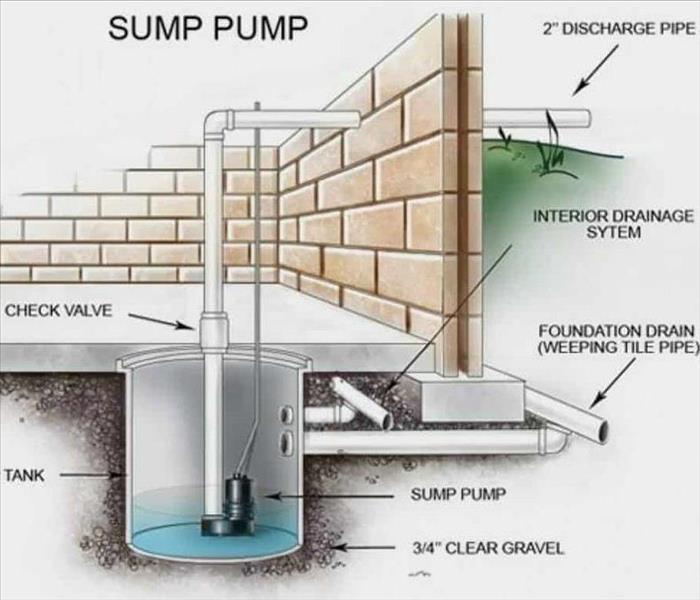 With heavy rains this Fall, have peace of mind by checking off that your sump pump is in working order.
With heavy rains this Fall, have peace of mind by checking off that your sump pump is in working order.
Sump pumps can prevent water from flooding the basement or crawlspace of your Camas, WA home. These pumps must be regularly cleaned and maintained in order to function properly. Learn the basic principles of keeping the sump pump in your home working and ways to ensure that it will operate in an emergency situation without electricity.
Keep the Pump Clean and Functional
Dirt, gravel, and other types of debris may cause blockages that force a pump to work harder to do the same amount of work. Pump maintenance involves regularly cleaning out the
- Bottom grate
- Discharge pipe
- Intake screen
- Pit
- Vent hole
You should also check the operation of the float mechanism. Buildup or malfunctions may result in damage to the pump or an eventual overflow.
Check Power Sources and Alarms
A sump pump should plug into a ground fault circuit interrupter or GFCI outlet. Make sure that
- The outlet is functional
- The power cord is in good condition
- The backup battery is replaced every two to three years
Some pumps have battery-powered water level alarms. If your model features emergency notifications, you should
- Turn on alerts
- Know what alerts mean
- Be able to receive alerts
Newer models may send alerts to a cell phone so that you will receive water level warnings no matter where you are.
Consider Backup Solutions
If the pump in your home does not have a back-up battery, you can rely on an alternative power source such as a
- Car battery
- Deep cycle boat battery
- Generator
You may also want to consider a back-up water-powered pump that is capable of working without a power source.
Cleaning and maintaining a sump pump can prevent flooding in the basement or crawlspace of your home. If a pump and backups fail and water levels start to rise, rely on SERVPRO of E. Vancouver/Clark County for damage mitigation services.
Prevent a Water Damage by Knowing Where to Look
8/16/2021 (Permalink)
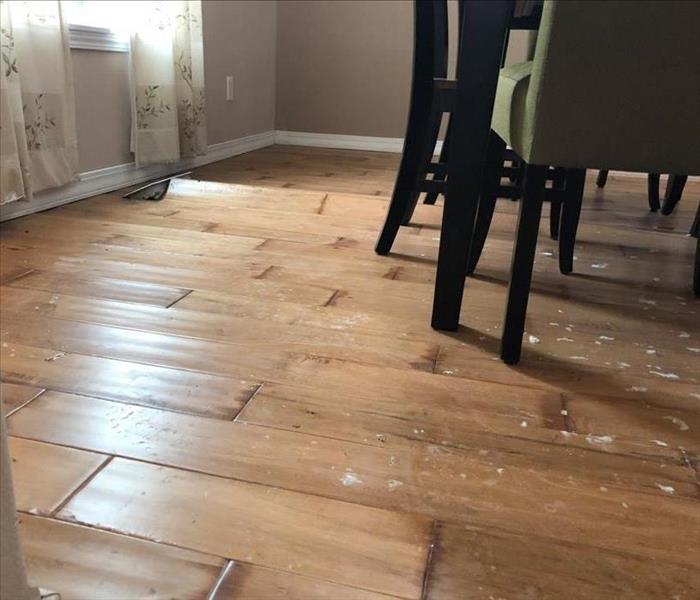 You know you can count on SERVPRO professionals, day or night, to minimize damage by removing water fast!
You know you can count on SERVPRO professionals, day or night, to minimize damage by removing water fast!
When you get water in home building materials, the damage is unavoidable and costly. Most materials swell or breakdown, and mold can become a secondary problem if water is not dried thoroughly. While water damage is a common problem that many homeowners experience, most of it is preventable. Here are some key systems, in and out of your home, to check right now to reduce your chance of water damage:
Pipes and Plumbing
Inspect pipes, hoses and connections in your search for drips and leaks since even the tiniest of these can develop into a significant pipe cleanup job. Sometimes you may not see leaking water, so you need to look for clues: rust, mold, stains, and damaged materials that peel or buckle.
Roof and Water Drainage
Check inside your attic and look for stains in the ceiling for signs of rain water in the home already. Check outside, during or after rain, to make sure gutters and downspouts flow freely. If you see areas that pool around your foundation, consider lengthening the end of your downspouts, adding French drains or grading the land away from your house.
Basement Pump System
Whether you have a storm or a broken pipe, the first line of defense in the basement is the sump pump. Clear debris from the pump so that it is ready for action. Periodically check your sump pump, by adding a little water to the sump pit, to make sure it works.
Septic Tank
You may think your tank doesn’t need pumped because you never have problems, but all that wonderful microbial digestion happening inside your tank still results in a byproduct of sludge that takes up valuable capacity and must be removed with periodic pumping. Check with your local extension for recommendations on septic pumping based on the size of your home and number of occupants.
Make flood water in the home an unlikely problem by routinely inspecting key home systems, and by doing maintenance routinely.
Classifying Types of Water Damage
8/12/2021 (Permalink)
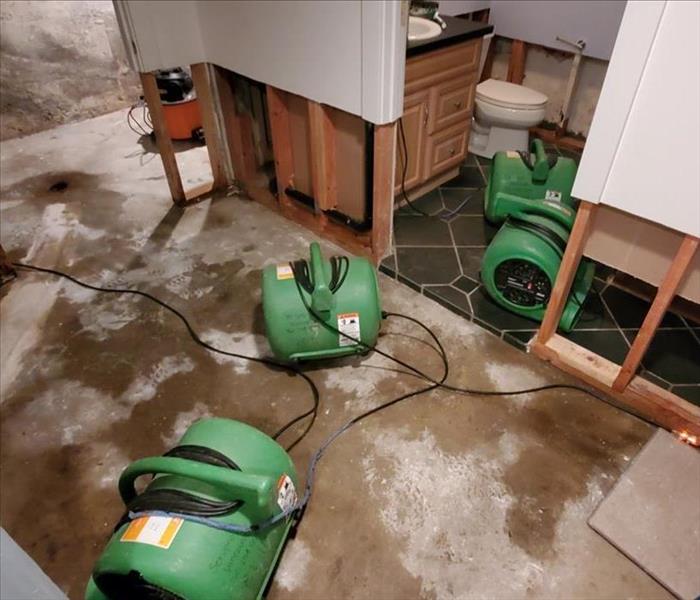 Give yourself peace of mind by calling SERVPRO of E. Vancouver/ Clark Co. (360) 254-0049
Give yourself peace of mind by calling SERVPRO of E. Vancouver/ Clark Co. (360) 254-0049
Water damages are a frustrating and time-consuming problem. When you take into account the risks associated with contaminated water and the possibility of secondary water damage, the entire situation can be very overwhelming. It's important that you identify the type of water you're dealing with before you decide to handle any repairs on your own. Sewer backups, for example, contain black water and should only be addressed by a professional.
1. Clean Water
Category 1 water is safe to handle. During a flooding situation, clean water may come from a leaky faucet or a break somewhere in the supply line. Unfortunately, if the situation isn't resolved, clean water can become contaminated and turn into category 2 or 3 water. Work quickly to thoroughly clean up and dry out your home when it is affected by clean water.
2. Gray Water
This contaminated water may cause trouble, but isn't as hazardous as black water, unless left untreated. It may carry viruses, bacteria, or urine, but it doesn't contain any feces. Overflowing toilets, dishwashers, and washing machines are some sources of gray water. Depending on what's in the water, it may be safe for you to handle this type of flooding on your own. If you aren't sure, contact a water damage specialist.
3. Black Water
The most serious of the three categories of contaminated water is black water. This type of contamination often contains untreated sewage, bacteria and viruses, chemicals, and microbial growth. Any contact with this type of water could lead to severe, lasting damages. Any water entering your home from the sewer system or from outside your home should be treated as black water.
Water damage is assessed to ensure the well-being of your family and home. Work closely with professionals who have the right training and equipment to deal with a flooding situation. You'll have lasting peace of mind, knowing that flooding has been dealt with appropriately.
What You Need to File a Water Damage Claim
5/24/2021 (Permalink)
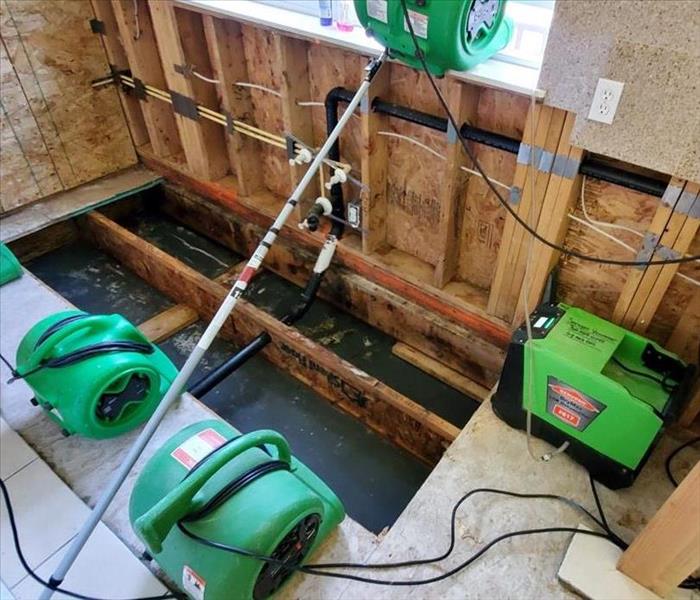 This kitchen experienced a leak that went unnoticed causing the damage to spread. Here you see drying equipment placed in the mitigated kitchen.
This kitchen experienced a leak that went unnoticed causing the damage to spread. Here you see drying equipment placed in the mitigated kitchen.
Documentation is required to file a homeowners insurance claim for water damage. A policyholder should provide photos, videos, maintenance records, and proof of purchase to an insurer as evidence of damage caused by a pipe burst or any type of leak. In this blog you can learn more about what information a homeowner should gather as he or she prepares to file a claim for water damage.
Proof of Damage
Insurers will want to see proof of the full extent of the damage. There are several types of useful documentation:
- Photographs
- Video
- Footage dated prior to an incident
These records indicate that damage was caused by the incident that led a homeowner to file an insurance claim. It is important to document damage before taking any steps toward mitigation. Homeowners may also benefit from being able to produce maintenance records indicating that the incident was not due to negligence. Even if an insurer does not cover the cause of damage, coverage should be available for the effects.
Proof of Purchase
It can also be helpful to gather receipts or other proof of purchase for damaged contents. Check your policy to ensure that the replacement cost of items is covered rather than the actual cash value. Given depreciation, the latter may not be sufficient to replace items with severe damage.
A Restoration Estimate
Insurers prefer to work with an established water damage mitigation and restoration company. Obtain an estimate for the cleanup and restoration processes by contacting a company that provides both services. This calculation may be more accurate and complete than estimates from more than one business.
All of this information can help a homeowner filing an insurance claim for water damage. Be aware that homeowners insurance does not cover any damage caused by flooding. A separate flood insurance policy is necessary for damage resulting from heavy rains or rising bodies of water in Camas, WA.
If you need any assistance with providing proper documentation to your insurer, please don't hesitate to ask for our help. We will also help you provide a list of all of your home's belongings.
Give us a call day or night! (360) 254-0049
Top 4 Things You Should Know About Plumbing Maintenance
5/24/2021 (Permalink)
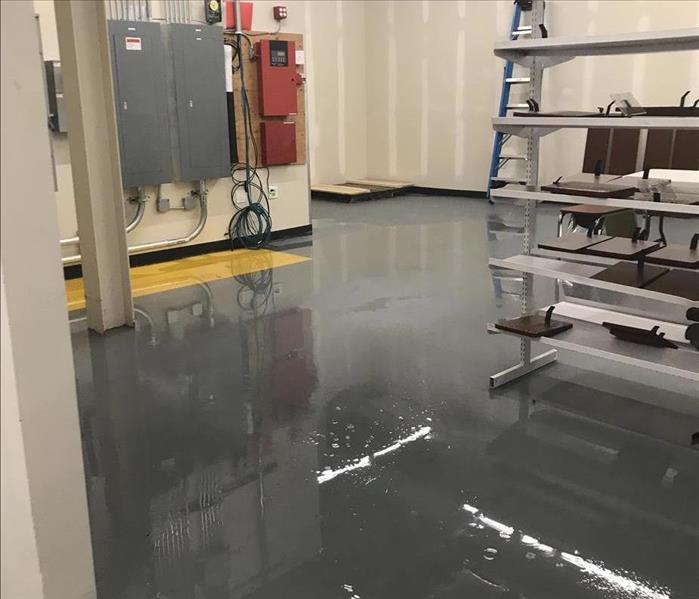 SERVPRO of E. Vancouver/ Clark Co. is always ready for your call (360) 254-0049
SERVPRO of E. Vancouver/ Clark Co. is always ready for your call (360) 254-0049
Plumbing problems can happen in any building. Normal wear and tear, plumbing age and quality of a system’s construction materials all have an impact on plumbing performance. Being proactive in keeping a Brush Prarie, WA commercial building’s plumbing system in good operating condition is a great way to protect your investment. It can also help you avoid a much more inconvenient and costly plumbing emergency in the future. Scheduling regular plumbing inspections may help identify small problems to be addressed before they become large. These four top checklist items for a plumbing maintenance inspection cover areas generally considered critical to proper operation of a plumbing system.
1. Fixtures
Quiet leaks and drips from fixtures such as toilets and faucets can waste thousands of gallons of water annually. Fixtures are typically tested during a maintenance inspection. Repairing these silent leaks may save a lot of money on future water bills.
2. Pipes
A visual inspection of pipes can be done to uncover evidence of leaks and signs of corrosion. When significant visible corrosion is noted, it may be a signal that the pipes are close to the end of their useful life. This can give you the opportunity to make a plan before the aging plumbing causes a bigger problem, such as a broken pipe.
3. Drains
A test of drains can uncover any blockages that need to be cleared. Slow draining sinks or toilets that require regular plunging may indicate a blockage. If allowed to persist, blockages can lead to backups and overflows with accompanying water damage.
4. Valves
Testing valves for proper operation may help prevent valve failure. Broken or faulty valves can add challenges to water main maintenance and repair. A simple check of a valve’s ability to open and close can be all that is needed to avert larger plumbing problems in the future.
While some plumbing problems may be unavoidable, it is generally much easier to make preventive plumbing corrections based on recommendations from a routine maintenance inspection than defer routine repairs.
Avoiding a Water Damage Catastrophe
4/4/2021 (Permalink)
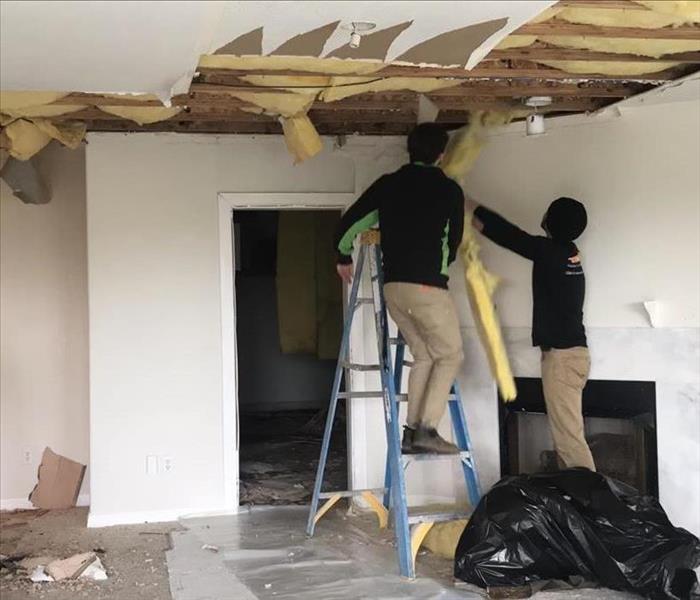 From inspection to reconstruction, our team is ready to help! Give us a call at (360) 254-0049
From inspection to reconstruction, our team is ready to help! Give us a call at (360) 254-0049
When you experience a water damage and the water has soaked into home building materials, the damage is unavoidable and costly. Most materials swell or breakdown, and mold can become a secondary problem if water is not dried thoroughly. While water damage is a common problem that many homeowners experience, most of it is preventable. Here are some key systems, in and out of your home, to check right now to reduce your chance of water damage:
Pipes and Plumbing
Inspect pipes, hoses and connections in your search for drips and leaks since even the tiniest of these can develop into a significant pipe cleanup job. Sometimes you may not see leaking water, so you need to look for clues: rust, mold, stains, and damaged materials that peel or buckle.
Roof and Water Drainage
Check inside your attic and look for stains in the ceiling for signs of rain water in the home already. Check outside, during or after rain, to make sure gutters and downspouts flow freely. If you see areas that pool around your foundation, consider lengthening the end of your downspouts, adding French drains or grading the land away from your house.
Basement Pump System
Whether you have a storm or a broken pipe, the first line of defense in the basement is the sump pump. Clear debris from the pump so that it is ready for action. Periodically check your sump pump, by adding a little water to the sump pit, to make sure it works.
Septic Tank
You may think your tank doesn’t need pumped because you never have problems, but all that wonderful microbial digestion happening inside your tank still results in a byproduct of sludge that takes up valuable capacity and must be removed with periodic pumping. Check with your local extension for recommendations on septic pumping based on the size of your Washougal, WA home and number of occupants.
Make flood water in the home an unlikely problem by routinely inspecting key home systems, and by doing maintenance routinely. You know you can count on professionals, day or night, to minimize damage by removing water fast.
Categories of Water Loss
3/10/2021 (Permalink)
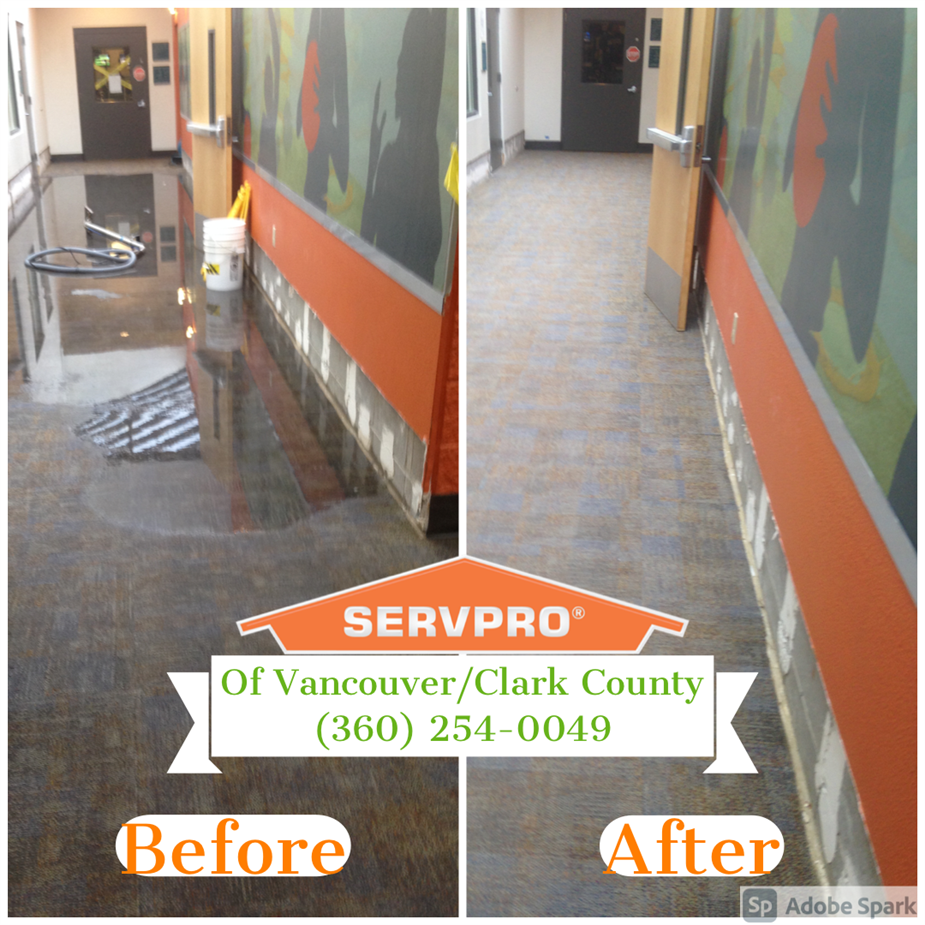 Call SERVPRO of East Vancouver/ Clark County (360) 254-0049 to make it “Like it never even happened.” We’re open 24/7
Call SERVPRO of East Vancouver/ Clark County (360) 254-0049 to make it “Like it never even happened.” We’re open 24/7
The IICRC’s S-500 Standard and Reference Guide for Professional Water Damage Restoration distinguishes water into three categories. Each category is defined by the levels of containment or possible containments in the source of the water.
Category 1 “Clean Water”
Water in this category originates from a clean, sanitary source and poses little to no risk to humans if contacted or ingested. Examples are broken water supply lines, sink or bathtub overflows, or water supplies to an appliance such as a water line to an ice maker.
Category 2 “Grey Water”
Water is this category comes from a source that contains significant contamination including chemical, biological, or physical materials. Grey Water has an elevated risk to cause illness and discomfort with any type of exposure. Examples are toilet bowls with urine, sump pump leaks, and discharged water from appliances like dishwasher and washing machines.
Category 3 “Black Water”
Water in this category is considered very harmful and contains unsanitary agents, dangerous bacteria and fungus, and toxic substances. This category of water has an extreme risk of causing illness and exposure should be avoided at all costs if the proper personal protective equipment is not available. Examples include sewage, seawater, and overflow from rivers or lakes. If left unattended Clean and Grey Water can become stagnant and may be considered Black Water.
If you have concerns with water no matter the source, SERVPRO of East Vancouver/ Clark County specializes in Water Damage Repair & Restoration and is a certified IICRC firm.
SERVPRO's Water Damage Process
1/18/2021 (Permalink)
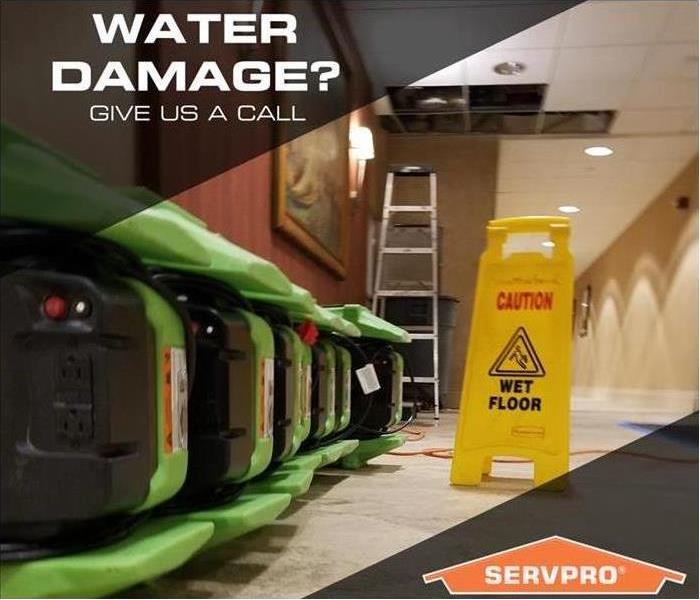 Every water damage situation is a little different, and requires a unique solution, but the general process stays the same.
Every water damage situation is a little different, and requires a unique solution, but the general process stays the same.
SERVPRO of Vancouver/ Clark County implement a course of action for restoring a property that has water damage. A quick response is key to preventing further damage.
There are five fundamental principles for water damage restoration which are noted in The Institute of Inspection, Cleaning and Restoration Certification (IICRC) S500 Standard and Reference Guide for Professional Water Damage Restoration:
- Safety
- Documentation
- Mitigation
- Drying Plan
- Cleaning and Repair
Safety is the primary concern on a job site. It is important to make sure the crews and the occupants are informed and protected from any safety issues.
Documentation is important to create an action plan for the project. At SERVPRO® we use DryBook® which is used on iPads that the crews bring on every job. Using DryBook® helps our crews document everything that is happening on the job, how to create a drying plan and to make sure the structure is drying properly.
Mitigation is important because it helps the occupant recover more quickly from the water loss event.
Drying plan includes removing excess water, extraction, evaporation and dehumidification. Drying equipment is placed to remove moisture through evaporation and dehumidification. Temperature is also important to increase the rate of evaporation.
Cleaning and repair are done when the drying plan is complete and drying goals have been met. This is to repair and clean the property to preloss condition.
SERVPRO’s Water Damage Restoration Process
11/13/2020 (Permalink)
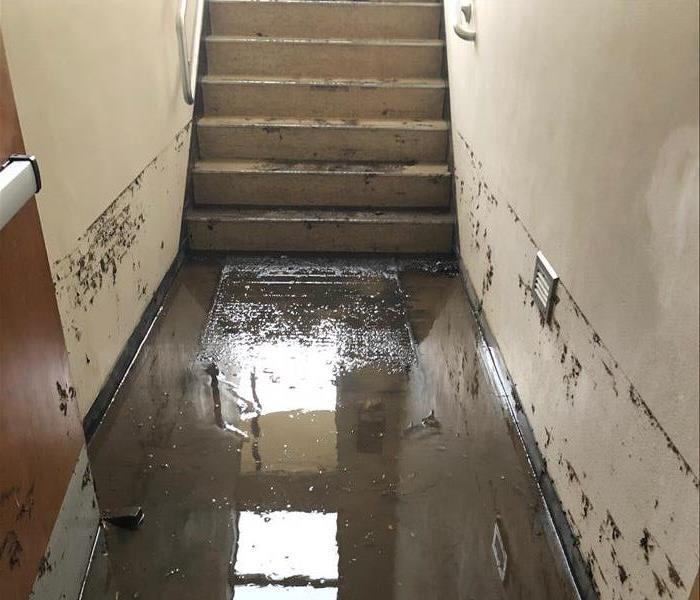 Having a Water Damage Emergency? Call SERVPRO of East Vancouver/ Clark County 24/7 at (360) 254-0049
Having a Water Damage Emergency? Call SERVPRO of East Vancouver/ Clark County 24/7 at (360) 254-0049
When your home or commercial property has water damage from flooding or leaks, we have the expertise and equipment to properly restore your property. Our experience and scientific approach to water removal and water cleanup enable us to properly dry and restore your property.
Water or Flood Damage?
Call Today – (360) 254-0049
Every water damage event is a little different and requires a unique solution, but the general process stays the same.
Step 1 - Emergency Contact
The restoration process begins when you call us. Our representative will guide you through the crisis and may ask several questions to help us better understand the equipment and resources we will need.
Step 2 - Water Damage Inspection and Assessment
We determine the scope of your water damage at this stage. We inspect and test to determine the extent of damage and how far the moisture has traveled to ensure proper and complete restoration.
Step 3 - Water Removal/ Water Extraction
The water removal process begins almost immediately and removes the majority of the water. We use powerful pumps and vacuum units to quickly remove hundreds or thousands of gallons from your property, which helps prevent secondary water damage and mold growth.
Step 4 - Drying and Dehumidifying
We use specialized equipment to remove the remaining water that is harder to access. Our Professionals will use room measurements, temperature, and relative humidity to determine the optimal number of air movers and dehumidifiers needed to dry your home or business.
Step 5 - Cleaning and Sanitizing
We clean all of the restorable items and structures damaged by the water. We are adept at cleaning contents using a number of techniques. Our professionals are trained to provide sanitizing treatments and to remove odors and deodorize your property.
Step 6 - Restoration
Restoration is the process of restoring your home or business to its pre-water damage condition. Restoration may involve minor repairs, such as replacing drywall and installing new carpet, or may entail major repairs, such as the reconstruction of various areas or rooms in a home or business.
Water Damage is NOT a DIY Job
8/21/2020 (Permalink)
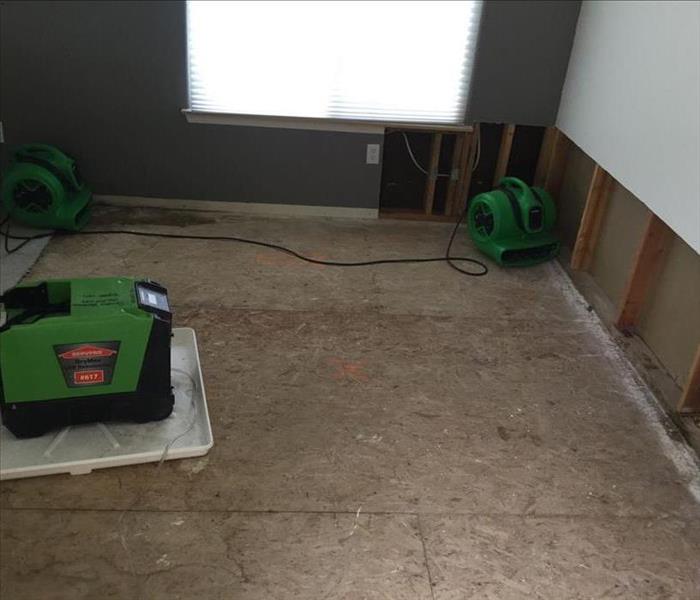 Have a water damage situation? Call SERVPRO of Vancouver/Clark County to get the job done right!
Have a water damage situation? Call SERVPRO of Vancouver/Clark County to get the job done right!
Despite the magazines, television shows, and internet articles that may have you thinking otherwise, water damage restoration is a job that should only be performed by certified professionals. SERVPRO of Vancouver/Clark County technicians not only have the know-how to get the job done right, but they also have the specialized tools needed to thoroughly dry your home, preventing further damage and even mold. Additional benefits of hiring a professional water damage restoration company:
- Health Hazards: Depending on the source of the water damage, safety can become a concern. There are three varying degrees of water damage, ranging from clean water to black water, each more hazardous than the next. Black water, the most dangerous of the three, is water that has come into contact with fecal matter, a haven for harmful bacteria and disease-causing pathogens.
- Hidden Damage: Water damage is not always obvious. Sometimes it is found inside walls and under flooring. If you attempt a DIY restoration and fail to diagnose hidden damage, the resulting issues could be extreme…and expensive.
- Peace of Mind: Hiring a professional restoration company gives you the peace of mind knowing you have done everything in your power to rectify the situation.
Your Belongings and Water Damage
8/14/2020 (Permalink)
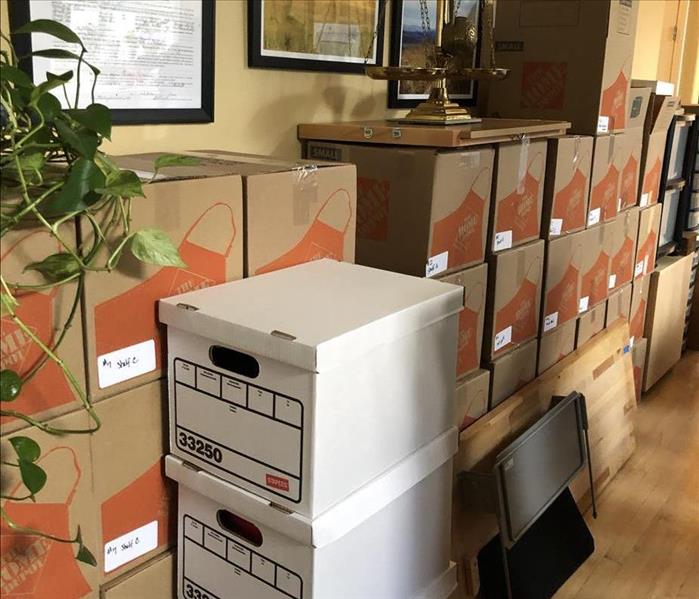 If You Have Questions or Need Help,
Call Us Today (360) 254-0049
If You Have Questions or Need Help,
Call Us Today (360) 254-0049
Water damage affects not only the structure of your house but also your belongings. SERVPRO of Vancouver/Clark County understands that your home is more than a structure; your family’s furniture, clothing, keepsakes, and other belongings help transform a house into a home.
Contents Restoration
We specialize in restoring contents damaged by fire, water, or mold. Our expertise and “restore” versus “replace” mentality can help you save money while preserving precious keepsakes that can’t be replaced. We pretest your contents to determine what items can be restored back to their condition before the water damage. We utilize several methods of cleaning your contents, including:
- Dry Cleaning - Used for cleaning light residues or to pre-clean prior to wet cleaning.
- Wet Cleaning - An effective cleaning method for removing moderate to heavy residues.
- Spray and Wipe -Effective for items that can’t withstand wet cleaning.
- Foam Cleaning - Used for upholstery fabrics that might shrink or bleed if wet cleaned.
- Abrasive Cleaning - Involves agitation of the surface being cleaned.
- Immersion Cleaning - Contents are dipped into a bath of the cleaning product.
Move-Outs/Pack-Outs
If your home requires extensive restoration or cleaning, SERVPRO of Vancouver/Clark County can conduct an organized, efficient move-out of the affected area. Move-out will provide several benefits, including:
- A quicker remodeling process
- Protecting items from potential damage
- Protecting contents from further on-site damage
When restoration is completed, they will work with you to coordinate the move-in according to your needs. The services offered upon move-in may depend on your insurance coverage.
Electronic Cleanup
Water-damaged electronics can present a serious hazard. Do not attempt to turn on or operate any electrical device that you suspect has been damaged by water. A SERVPRO Franchise Professional will coordinate the restoration of your electronics, including:
- Television sets
- DVD players
- Computers
- And more
The key to restoring electronics is taking prompt action to prevent further damage. They start by cleaning the exterior of electronic devices to help stop further corrosion and damage. Electronics will be cleaned and inspected by a qualified electronics technician.
Contents Claim Inventory Service
When a fire emergency strikes, the damage can often feel overwhelming. We can help ease the worry and confusion during the recovery process by offering our Contents Claim Inventory Service (CCIS), which provides a detailed and accurate list of your belongings. They take a room-by-room inventory of your contents, including digital photos, and in some instances, bar coding..
Our Contents Claim Inventory Service:
- Pre-loss list and value of contents
- Detailed and accurate report
- Better information to settle claims quicker
- Assistance with burden of proof for claims
- Peace of mind when you need it most!
Top 4 Causes of Commercial Water Damage
5/29/2020 (Permalink)
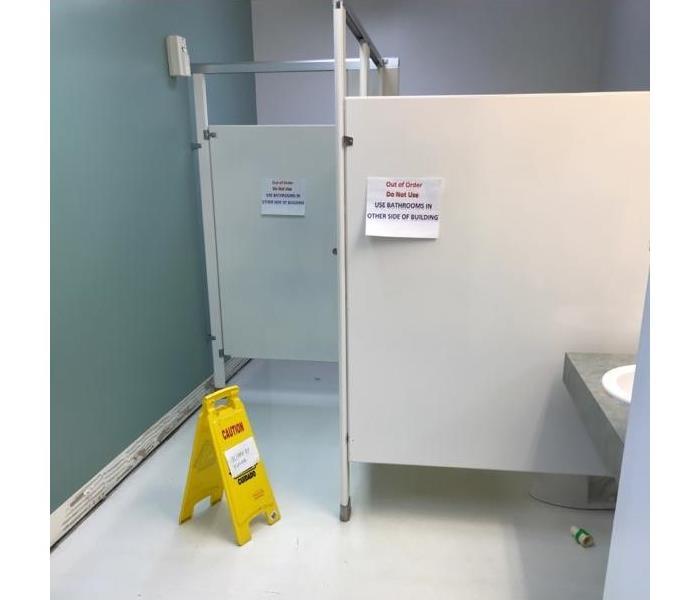 For a quick response, the latest technology, and the best customer service, call SERVPRO of Clark County at (360)254-0049, We’re here to help!
For a quick response, the latest technology, and the best customer service, call SERVPRO of Clark County at (360)254-0049, We’re here to help!
Leaks and cracks can turn into a downpour and flood an entire area or property.
Extensive water damage can happen very quickly. It only takes one broken pipe or a small roof leak to turn into a downpour that can flood an entire area or property.
If your commercial building is not in immaculate condition, you are at risk for water damage. By becoming familiar with the top 4 causes of water damage, you can be better prepared in case of an emergency and minimize lost revenue as a result of downtime.
Broken or Leaky Pipes and Drains: Your plumbing system is always at-risk for developing clogs, stoppages, and leaks. If a crack develops, it can spill 250 gallons of dirty water in your facility. This is especially dangerous in restrooms, where sewer water can be filled with hazardous waste.
Look for any outward signs of moisture, rusting, or cracking pipes. Additionally, always keep pipes insulated if they are exposed to lower temperatures to prevent freezing.
Active leak detection systems can be valuable as they can detect and stop leaks from happening.
Sprinkler Systems: Commercial buildings are required by law to be equipped with sprinkler systems. The system works in conjunction with the fire alarm to turn on anytime the fire alarm is activated. This makes them very valuable in preventing fire damage, but simultaneously causes water damage in the process.
In addition, sprinkler systems can malfunction and cause water damage all on their own. Always check your sprinkler system for signs of damage or rust.
Appliances and Equipment: If your facility contains equipment or appliances that utilize water, such as air conditioners, washing machines, refrigerators or water heaters, leaks or breaks are a constant concern.
The best action you can take is to regularly inspect and maintain your equipment. Take preventative measures: replace water lines, re-caulk, and re-seal.
Roofs: Leaky roofs are the most common cause of water damage, especially in geographies that frequently experience hail or freezing temperatures.
If there is a large volume of water accumulating on your roof, you should probably have that inspected by a professional. One inch of water weighs almost five pounds and over time, this can cause strain and damage to your building.
You can rely on SERVPRO of Vancouver/ Clark County if you experience any kind of water damage in your home or business.
My Sump Pump Failed, Now What Do I Do?
5/26/2020 (Permalink)
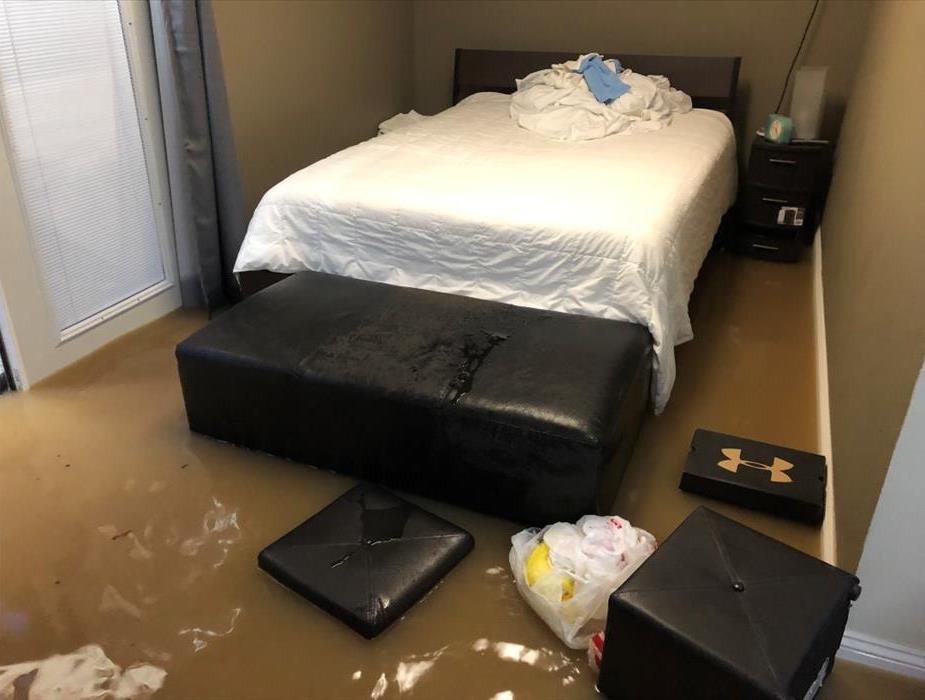 If you experience a sump pump failure and need to call someone you can trust, call SERVPRO of Vancouver/Clark County (360) 254-0049
If you experience a sump pump failure and need to call someone you can trust, call SERVPRO of Vancouver/Clark County (360) 254-0049
Not all areas of the country have basements, but here in the Pacific Northwest we certainly do. It’s smart to have a sump pump (or 2) in the lower spots in the basement. If you’re going to spend money to have a finished basement, it’s only smart to protect that investment by installing a relatively inexpensive (at least as it compares to the cost of a typical basement finishing project) water mitigation system. But like any mechanical system in your home, it’s not fail proof. In fact, all too often when they’re expected to perform to protect your home they fail and the consequences can be disastrous.
What do I do if my sump pump fails?
In most cases sump pumps fail during rain events. When that happens, the water usually seeps in through the foundation or basement walls and begins pooling in the lowest area of the basement, gradually rising as more water comes in. So what do you do at that point? Here are a couple of suggestions we have to help you navigate a difficult situation.
First, you’re going to need to get the sump pump fixed. A plumber is going to be necessary to get the sump pump back up and running. Immediately call a licensed plumber in your area and get on their schedule as quickly as possible. During rain events, it’s not unusual for many homes in the area to suffer the same fate as you, so plumbers will get booked up quickly. Act fast and call for their help!
Second, call SERVPRO of Vancouver/ Clark County. Make sure your sump pump is fixed before having the water removed; only once the source of the issue has been fixed can the restoration process begin.
Third, consider making a quick run up to your local hardware store to purchase a basement water pump. These pumps can operate continuously during the water event and suck up the water that is pooling and then transport it by hose into a bathtub or other drain. They can work in very little water (the one we linked works in 1/16th inch of water) and if the water stops it automatically shuts off so it doesn’t burn up. You can get a good water pump for under $100.
We’re Your Local Water Damage Specialists
4/23/2020 (Permalink)
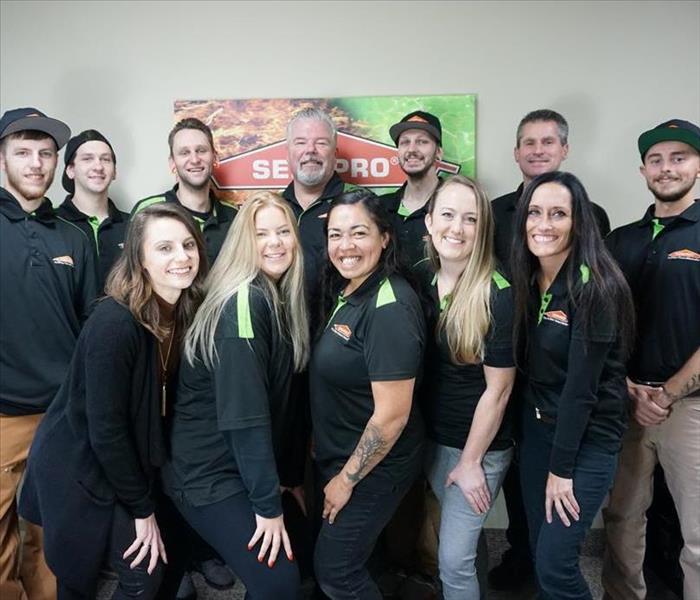 Our team lives and works in Clark County to serve you! We are your neighbors and friends, just call when you need us.
(360) 254-0049
Our team lives and works in Clark County to serve you! We are your neighbors and friends, just call when you need us.
(360) 254-0049
When water damage puts the things that matter most on the line, you need the very best help on their way. Knowing the easiest ways to contact the SERVPRO nearest to you is so important. Just visit https://www.SERVPROevancouverclarkco.com/ on your computer, tablet, or mobile device or simply call (360) 254-0049 to get the team that’s faster to any size disaster.
We’re the leader in the water restoration industry and we’re here to give control back to homeowners, property managers, and even entire communities after the devastating effects of water. So whether you are responsible for 1,000 square feet or 100,000—be ready for the worst with the very best: SERVPRO of East Vancouver/ Clark County.
With a network of more than 1,700 franchises ready to help in the event of a massive water loss, our local team, owned by Paul and Melinda McGraw, has all the resources needed to take care of you. When you call SERVPRO, you’re calling a company that works with your insurance company and the insured, as well as thousands of commercial property owners in North America. SERVPRO® is a brand you can trust…and we’re just down the street.
Overflow May Be Larger Than You Expect
3/11/2020 (Permalink)
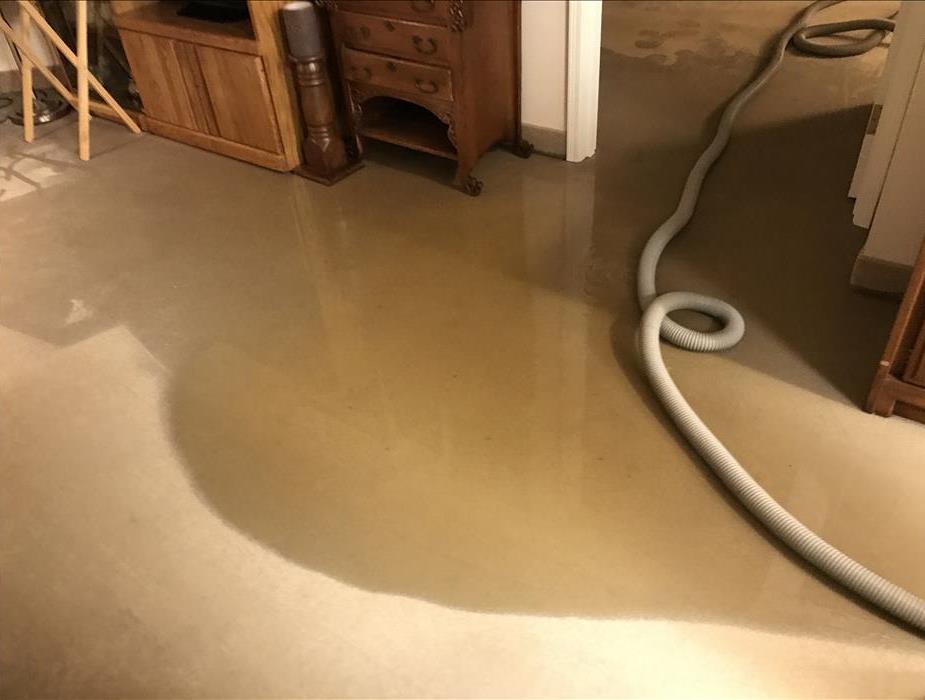 For a professional experience, call SERVPRO of Vancouver/ Clark County for all of your water damage needs at (360) 254-0049
For a professional experience, call SERVPRO of Vancouver/ Clark County for all of your water damage needs at (360) 254-0049
Protect your Camas-Washougal home from potential water-related damages and call SERVPRO of Vancouver/ Clark County immediately.
Water Overflows May Seem Minor
A sink or tub overflow may seem like an issue you can solve yourself but in failure of having professionals check or assess the water damage in your Camas-Washougal home, that overflow may cause unforeseen damage. Water can travel through surfaces, including cracks in tile, or unsealed grout lines causing further water spread in new areas; potentially posing new threats as the perfect breeding ground for fungi. Our team is trained and certified to assess water overflow and detect any moisture of traveling water using thermal imaging cameras, and moisture meters. Once all water has been extracted, your home calls for an assessment from our Institute of Inspection Cleaning and Restoration Certification (IICRC)-trained Water Damage Restoration Technicians (WRT). Technicians will repeatedly check moisture levels in your home throughout the restoration process to ensure the fastest recovery possible.
Once the water has been extracted and water damaged materials have been mitigated, SERVPRO of Vancouver/ Clark County is certified for the full restoration of your home or business to preloss condition. Ensuring not only the threat of water is removed but your home is rebuilt without having to consult outside construction companies, making your circle for repairs much smaller and simpler. The smaller your circle the easier and faster repairs to your home can be rebuilt.
Water Damage Solution
1/20/2020 (Permalink)
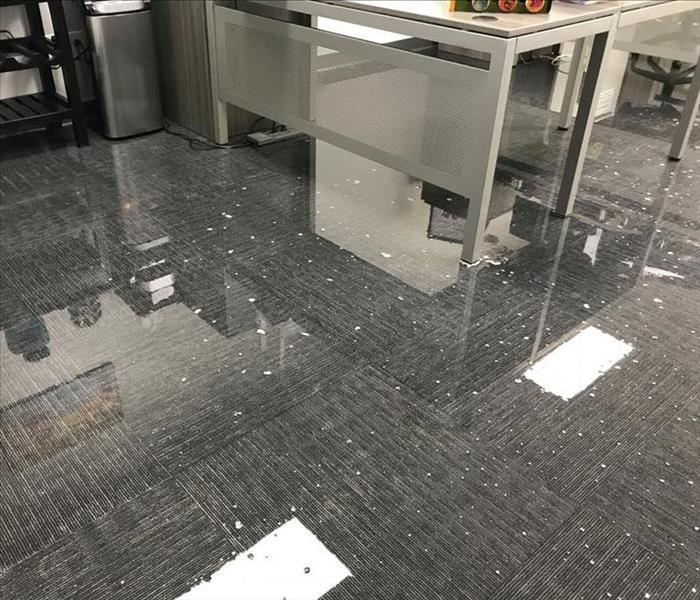 We made it priority to know the immediate needs and concerns of this office before we started work.
We made it priority to know the immediate needs and concerns of this office before we started work.
A pipe bursts. A water heater leaks. A bathtub overflows. Floodwaters rush in. A sprinkler system malfunctions. Water damage can happen in any number of ways. But if your business or home is under a few inches of water, everything else takes a backseat. Only one thing matters when your business can’t operate, and there is just one thing on the mind of the waterlogged resident: a solution.
SERVPRO of East Vancouver/ Clark County is that solution. Equipped with the knowledge, experience, and the training to help make your water damage “Like it never even happened,” SERVPRO professionals will start helping the moment you call. Backed by more than 40 years of experience, SERVPRO will help put your worries at ease, because they understand the science of drying.
When water damage strikes, give SERVPRO of East Vancouver/ Clark County a call; they will help to make things right, make things dry and make it “Like it never even happened.”
When Water Damage Strikes
11/19/2019 (Permalink)
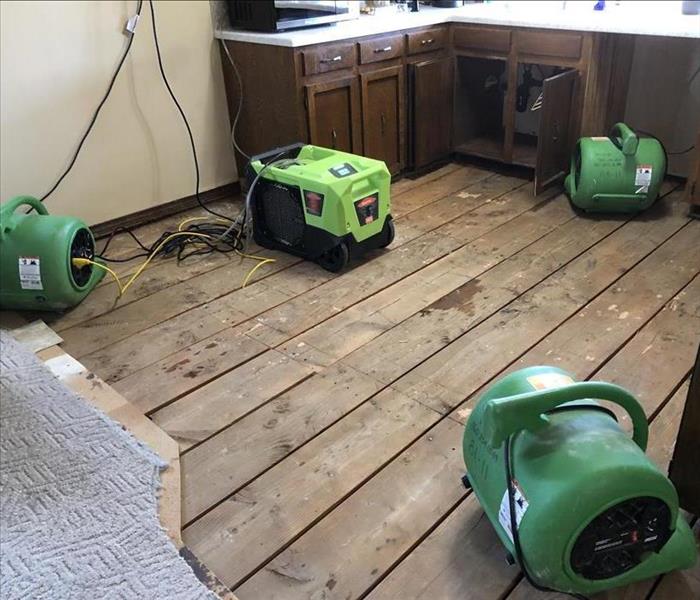 This kitchen experienced a leaking dishwasher. After the inspection, the affected materials were removed for proper drying.
This kitchen experienced a leaking dishwasher. After the inspection, the affected materials were removed for proper drying.
The first 24 hours following a water loss are the most important in preventing secondary or permanent damage. Within four hours of last notification, SERVPRO of Vancouver/ Clark County will be on site to help ensure a water damage is handled by completing the following steps.
Inspection
SERVPRO of Vancouver/ Clark County will inspect affected areas to determine the extent of water damage and will review the inspection with you to answer any questions before beginning any work.
Emergency Services
SERVPRO Vancouver/ Clark County will take steps to help protect your home or business, as well as personal belongings and other contents, from further damage by extracting the excess water and preparing the area for drying. They will explain the needed emergency services to you step-by-step.
Monitoring
To help ensure your home or business and belongings are drying to appropriate industry standards, SERVPRO of Vancouver/ Clark County will monitor the drying process. These updates will be consistently communicated to you.
Restoration Services
SERVPRO of Vancouver/Clark County will repair structural materials, reinstall carpet, and clean affected areas of your property and belongings. A final walk-through of the jobsite will be conducted with you to help ensure the property was returned to preloss condition.
SERVPRO Specialists Act Fast In Vancouver To Restore Your Home After Water Damage
8/22/2019 (Permalink)
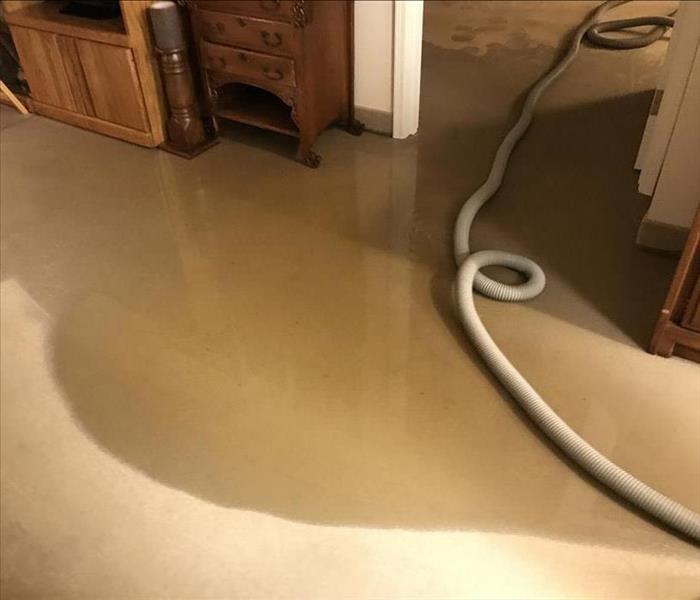 We have state of the art equipment to restore your home after water damage. We are available 24/7 so call us right away to prevent further damage.
We have state of the art equipment to restore your home after water damage. We are available 24/7 so call us right away to prevent further damage.
Residential Water Damage Restoration For Vancouver Homes
Despite having the Columbia River for its entire Western and Southern borders, much of Vancouver homeowners’ water intrusion issues come from smaller problems like broken dishwashers and split hoses.
Restoring this type of Vancouver water damage is simple, in that it carries no outside contaminants like in floodwater from outside the residence. Since it is smaller in scope however and does not involve an event like a severe thunderstorm, it and the leak itself can go undetected and unreported for much longer. Regardless of the water source; however, there are certain tasks SERVPRO response specialists need to immediately accomplish to preserve as much of the home as possible.
First up is water removal to stop further damage. Specialists begin with pumps to pull water from the lowest point in the home. At other areas and for items like carpets, they utilize smaller extraction devices that team members can adjust for vacuum speed and even temperature to begin drying carpets simultaneously.
As they complete removal procedures, other SERVPRO team members begin drying the home to lower the humidity level and reduce the risk of mold spores expanding and growing. It includes basic actions like opening all windows if the weather co-operates to setting up dehumidifiers to draw moisture from the air, and exhaust fans to increase air circulation and direct the damp, inside air to the outside of the structure.
As the air dries, specialists begin checking the floors and walls for water damage. Wood floorboards can swell, crack, and split if they absorb too much water. If there is only swelling, team members can use air movers to carefully direct warm air across the affected surfaces which force out the excess moisture while not stressing them and inadvertently cause cracking or splitting as secondary damage.
Team members examining the walls look for soaked drywall near the floor. In many cases, specialists can remove the floor trim and allow natural evaporation to dry the panels only slightly affected. If the panels became very soaked, then they may require either demolition and removal, or using the same type of air mover to force out moisture and carefully dry them to avoid the cost of replacement panels.
If you have had any water intrusion, contact SERVPRO of E. Vancouver / Clark Co. at (360) 254-0049 today. We proudly support our neighbors here and in Brush Prairie, Camas, and Washougal with the most up-to-date training and access to a nationwide network of the latest restoration equipment available.
See more about Vancouver.
Don't Let Water Cause Damage To Your Vancouver Attic
6/6/2019 (Permalink)
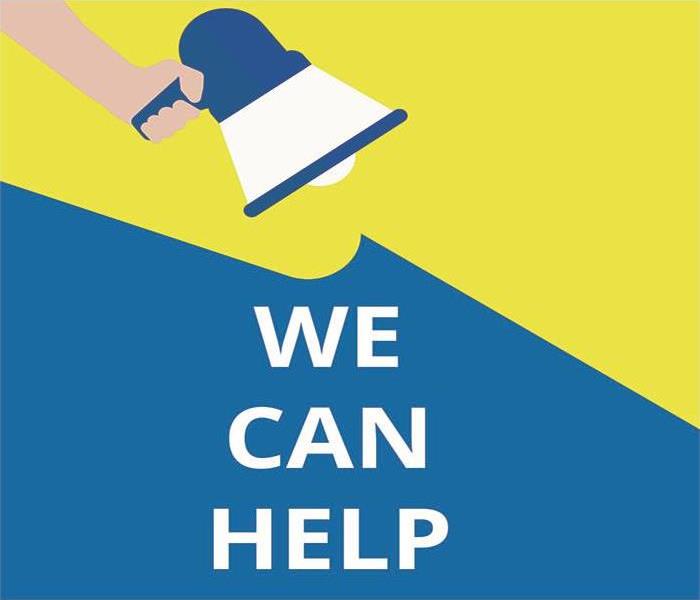 Our SERVPRO of E. Vancouver / Clark Co. can help you to quickly address water loss incidents in your home with our experience and advanced equipment.
Our SERVPRO of E. Vancouver / Clark Co. can help you to quickly address water loss incidents in your home with our experience and advanced equipment.
Moisture In Your Attic Can Damage Your Vancouver Home
After heavier winters, roofs of Vancouver homes can become slightly structurally compromised against the weight of substantial snowfall they have supported throughout these harsher months. While this alone can begin to show signs of degradation and wear for spaces like your attic, it can also allow moisture penetration to begin as well. Under these circumstances, saturated materials can begin to erode, and conditions remain ideal for secondary effects like mold and microbial growth to take hold.
While many homes have strong construction to withstand the harsher weather months, it is not easy to avoid water damage. Our SERVPRO professionals respond quickly to water loss emergencies in Vancouver because even moisture penetration can spread harmful effects throughout this area of the property beyond the source. Instead of contending with a small damp area, now our professionals must address an entire moist attic space that threatens to spread even farther to the levels below.
The unnerving truth about this kind of damage is that many homeowners do not even know when this problem has started. Often, these situations have to get bad enough to begin affecting the ceiling of the floors below until a property owner can notice. With attics being such a low traffic area, this moisture and dampness can affect the entirety of this upper area before moving to a place where it can begin to harm the household.
From both the attic to the affected construction materials below, our SERVPRO professionals must address all of the spreading dampness with state-of-the-art drying units like our air movers, our dehumidifiers, and our Injectidry system which can address cavities and crevices.
While oversaturation can often result in a need for replacing damaged construction materials, our contracting specialists must also address the roof damage, which allowed the moisture in the first place. We have an experienced team of general contractors to help.
Our SERVPRO of E. Vancouver / Clark Co. can help you to quickly address water loss incidents in your home with our experience and advanced equipment. Give us a call anytime you need us at (360) 254-0049.
Click here for more about Vancouver.
How To Minimize the Risk of 3 Common Commercial Sewage Issues
4/18/2019 (Permalink)
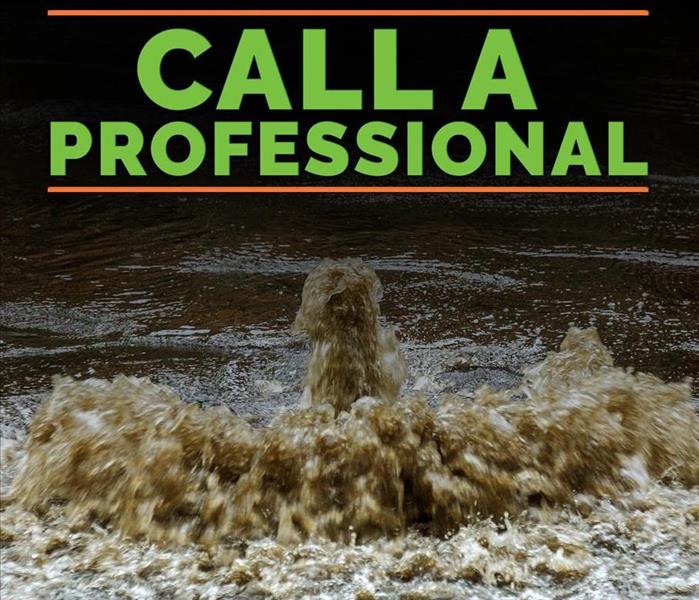 If you experience sewer blockage promptly contact a licensed plumber.
If you experience sewer blockage promptly contact a licensed plumber.
Key Tips To Minimize The Risk Of Commercial Sewage Issues
Many commercial buildings in Camas, WA, may be vulnerable to plumbing and sewage problems. Severe issues may result in significant and costly damage. Fortunately, there are several key tips every business owner can follow to minimize the risk of a blocked sewer and prevent major sanitation concerns.
1. Toilet Clogs
Clogs are a common commercial plumbing issue that can cause an unsanitary toilet overflow. This situation requires prompt sewage cleanup. Flushing paper towels, feminine hygiene products and wipes often contributes to sewer line obstructions. To reduce this risk, ensure garbage cans are available throughout the restroom. You can also post signs encouraging patrons to properly dispose of waste products.
If you notice a clogged commode, use a plunger or drain auger to clear the blockage. Refrain from pouring chemical cleaners into your system. These solutions can corrode pipes and push obstructions farther into your sewer line.
2. Sewer Blockages
Intrusive tree roots and debris can result in a blocked sewer line. Consistently clogged toilets or slow drains often indicate a blockage that’s causing sewage to back up into your building. If you experience these situations, promptly contact a licensed plumber.
Avoiding chemical drain cleaners and improper trash disposal can minimize sewer blockages. You should also be aware of the location of your building’s water and sewage lines; plant trees and shrubs away from these areas.
3. Broken Pipes
Aging infrastructure may leave your business susceptible to pipe breaks. Protecting your building’s plumbing lines from root infiltration and extensive chemical exposure can help preserve the system’s integrity. A licensed plumber can also employ specialized tools to evaluate the health of aging pipes and proactively address areas of concern.
Severe plumbing problems can cause damage, as well as lost production and revenue. Making conscientious maintenance and landscaping decisions can spare your business from a blocked sewer and other sanitation issues, helping to safeguard your investment.
The Stress-Free Guide to Flushing a Water Heater
3/14/2019 (Permalink)
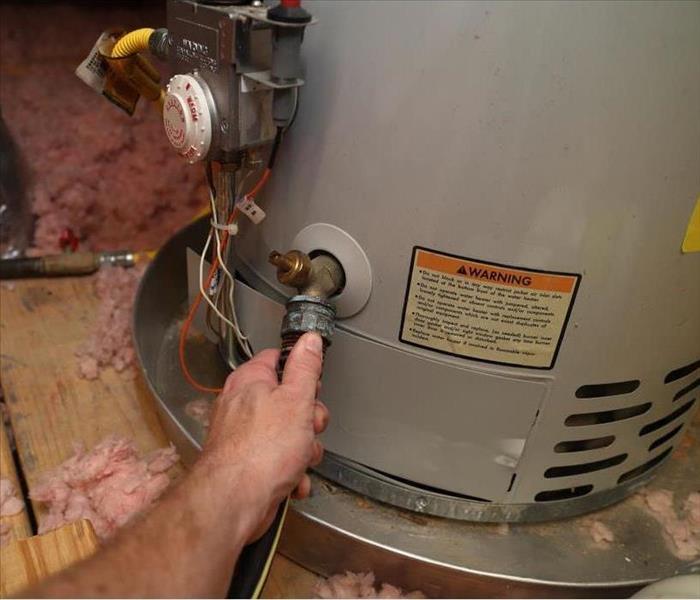 Flushing a water heater in Livingston, WA
Flushing a water heater in Livingston, WA
When is the last time you flushed your water heater? It’s nice to think of it minding its own business and working perfectly with no assistance. However, as the unit operates, it will likely become clogged with debris and minerals that can shorten its lifespan. The best maintenance practice for this household staple is to perform a water heater flush every few years, especially if you have hard water in Livingston, WA.
No Rush, Just Flush
Here is a cheat sheet to keep handy as you flush your water heater.
1) Establish whether you have a gas or electric unit. If it’s gas, turn off the thermostat, then the gas valve. If it’s electric, switch off the heater’s power breaker.
2) Find the cold water supply valve; switch it off.
3) Run a hot water tap in a sink to keep water flowing through the pipes.
4) Find the pressure relief valve. Place a basin underneath and carefully open the valve, avoiding the hot water discharge.
5) While the water in the tank cools, set up a garden hose with one end in a large bucket.
6) Once the water is cool, connect the hose to the tank’s drainage spigot. Turn on the spigot and watch the water that emerges in the bucket until it is sediment-free and clean.
7) Flush! Turn on the cold water supply valve into the tank. Let the water run until the hose water runs clean again.
8) When you are satisfied with the water quality, start reassembling everything. Turn off the drainage, remove the hose, and close the pressure relief valve again. Wait until the tank is full again from the cold water supply; once it is, open the pressure relief valve. Check another sink in the house to let out any air. Either turn the gas back on and light the pilot light, or flip the breaker switch back on. In half an hour, check your sinks for hot water.
Congratulations! You have successfully flushed your water heater. Clean up, cross the task off your to-do list and relax this weekend. Don't feel like taking these steps yourself? You can always enlist the help of professional water restoration services.
5 Things You Need To Know About Broken Pipes
1/18/2019 (Permalink)
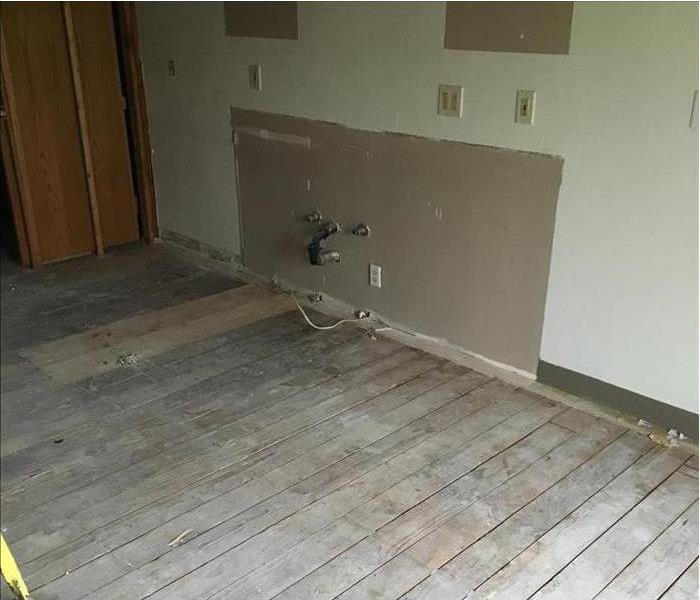 Water leak in a Camas, WA home
Water leak in a Camas, WA home
5 Things You Need To Know About Broken Pipes
To get the most out of your Camas, WA, home, you need a functioning plumbing system. After all, you probably use running water in your house every day. Therefore, you must watch for the warning signs of plumbing damage. Here are five things you need to know about a pipe burst.
1. Pipes Freeze
When temperatures drop, the water inside your pipes can freeze. As you probably know, water expands as it freezes. This expansion can cause your water line and other pipes to break.
2. Crowded Cabinets Hide Leaks
The areas beneath your kitchen and bathroom sinks are good places to store household chemicals and other items. If you overcrowd these spaces, though, you may not notice a water leak. Accordingly, routinely clean out cabinets and inspect your plumbing system.
3. Plumbing Systems Should Not Be Loud
Pipes generally make a bit of noise when water passes through them. Knocking, creaking, moaning and other noises, however, are not normal. If you have noisy pipes, you may need to take steps to protect your pipes from extensive damage.
4. Water Heaters Require Flushing
While a pipe burst can cause a mess, flooding from an old, damaged or ineffective water heater can be just as bad. By regularly flushing your home’s water heater, you remove sediment before it can cause a catastrophic problem.
5. Water Damage May Be Extensive
Even with your best efforts, you may not be able to avoid a home flood. You must understand that floodwaters can cause extensive damage. If your home survives a flood, consider working with a floodwater restoration service to be sure you restore your house to its pre-flood condition.
Like most homeowners, you don’t want to have to deal with a pipe burst. By understanding some fundamental facts about broken plumbing, though, you can develop a plan for keeping your home’s pipes in excellent shape.
Holiday Home Maintenance: Water Heater Flush
12/24/2018 (Permalink)
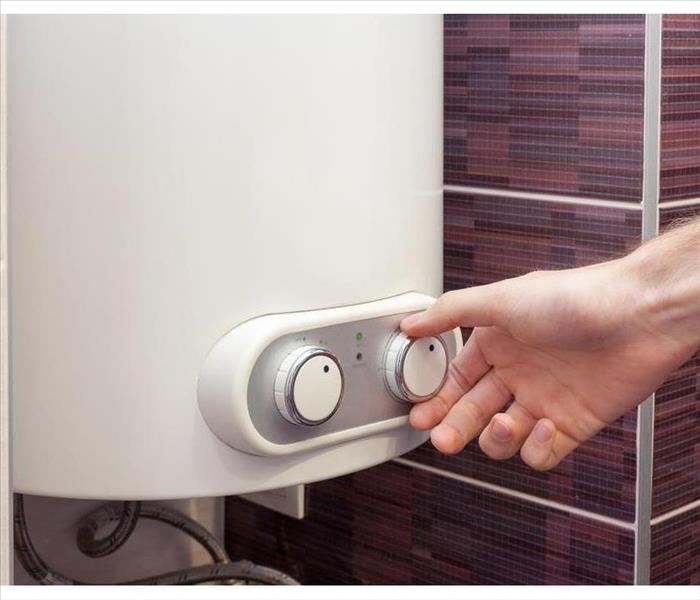 Check your water heater in Vancouver, WA
Check your water heater in Vancouver, WA
Prepare for holiday guests by making sure your water heater is working its best. If you are hosting some out-of-town guests at your home in Vancouver, WA, you are probably busy making sure your guests will feel welcome and comfortable. A lot of additional demand will be placed on your hot water tank this holiday season, so here is a brief guide that will help you be ready. This is an easy way to ensure holiday memories aren’t tarnished with cold showers and house floods.
Quick Guide for a Water Heater Flush
- Turn off electricity by finding the designated switch in the breaker box.
- Connect a hose and open the drain valve.
- Turn off the water supply.
- Refill the tank.
- Turn on power.
Because the water is very hot, be sure to use caution. Make sure you don’t touch the draining water and protect your hands by wearing gloves when handling the hose.
Read These Tips Before You Start
While the steps are simple, there are a couple of tricks that will help you after you start draining the water heater. First, make sure the pressure release valve is open. This is located on top of the tank. Close this valve again when you are ready to refill the tank.
Second, turn on the hot water at your kitchen faucet. This creates some air that will help with draining the tank. Don’t turn the faucet off until you have finished refilling the tank. The water at your kitchen faucet will start flowing normally again when the tank is full.
Ensure a Smooth Holiday
Low water pressure or a flood from an eroded water tank can interrupt your holiday and leave you unable to give house guests what they need. Prevent water heater problems by doing maintenance once a year. If you haven’t flushed your tank in a long time, do it now! Flood damage restoration is probably not something you want to do during the holidays, but thankfully there are experts available if you do have an emergency.
Fixing a Basement Flood in 3 Steps
10/8/2018 (Permalink)
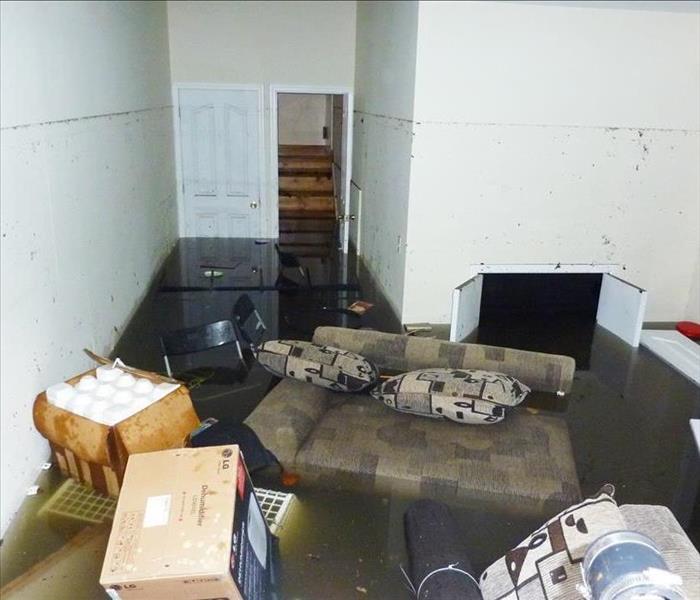 Flooded basement in Vancouver,WA
Flooded basement in Vancouver,WA
Sometimes you do all the right things to prevent a flooded basement, but it still happens. This is often due to extreme weather or a mechanical failure with the sump pump. Basement flooding is a big job that needs your immediate attention. Though it is a lot of work, it comes down to three key steps:
1. Be safe
Electrical shock is the biggest, most immediate risk to your health when you have a basement flood. Once water is in contact with live electricity, you cannot enter or even touch the water. Be sure to have the electricity (and gas) to your property turned off if the water in your basement is high enough to reach electrical outlets or other appliances.
2. Remove water
Once the electricity to your property is turned off, you need to remove all the water from the basement flood. It’s ideal to have the water pumped, so the job can be done as quickly as possible. If you are waiting for professional help to arrive, go ahead and use any resource you can to start water removal. Materials begin to break down quickly in water, and mold can even start developing in the first 24 to 48 hours.
3. Clean and restore
Building materials that are below the flood line are going to need to be removed and replaced. This may include subflooring, carpet pads, and wallboard. Electrical outlets and wiring that have been submerged should also be replaced. Carpet damaged from a basement flood of Category 1 water may be saved and dried outdoors. Wallboard above the flood line may also be saved.
Don’t assume flood damage in Vancouver, WA, is included under your insurance coverage. Water damage is a complicated claim, and it’s typically not covered if the damage is from a weather-related event. Sudden and unexpected floods from pipe or line failures are typically covered; however, not if the damage is due to the neglect of a leaky pipe that had been ignored.
What To Do After a Toilet Overflow
8/14/2018 (Permalink)
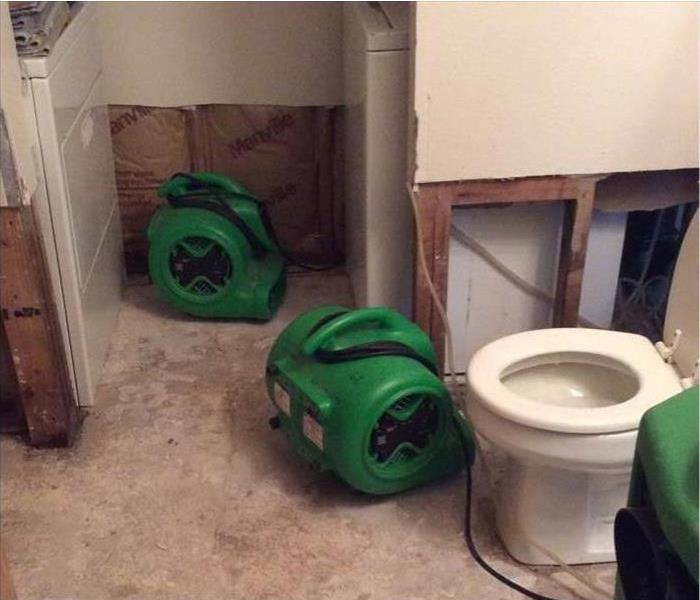 Air mover on water loss bathroom in Vancouver, WA
Air mover on water loss bathroom in Vancouver, WA
An overflowing toilet is a frustrating problem, no matter what the circumstances involve. However, when the overflow involves a sewage backup, the problem becomes much more serious. Sewer damage could contain viruses, bacteria, and other illness-carrying microbes. The possible risks associated with contamination could affect your Vancouver, WA, home and your family for many years.
- Toilet Overflow: Blockage in the plumbing system causes the toilet to overflow. In this case, the flooding water hasn't passed through the sewer system. Water damage may occur, but you won't have to involve the sewage company.
- Plumbing System Overflow: Water from the sewage system backs up through residential lateral pipes and into homes. This water is often filled with serious contaminants, such as raw sewage.
If you can't tell whether you have an overflowing toilet or a sewage situation, contact a professional immediately. If you have a flooded toilet, you may be able to handle the problem yourself.
Step 1: Stop Flushing
Much of the time when homeowners see something they don't like in the toilet, they flush. Unfortunately, this will only make a flooded toilet situation worse. Each flush contains more than a gallon of water that you'll have to clean up off the floor.
Step 2: Turn Off the Water
There should be a water shut-off valve located near the floor behind the toilet. Once the water has been shut off, you won't have to worry about more water making the situation worse.
Step 3: Clean Up Spilled Water
If the toilet was only flushed once or twice, you can probably mop it up pretty quickly. If there were more flushes and the resulting four to five gallons of water, you may want to contact a professional to prevent water damage.
Step 4: Address the Clog
Hopefully, you'll be able to dislodge whatever was stuck in the pipes and return to your normal daily activities. Otherwise, you may need to contact a professional.
Remember to protect your home and family from sewer damage. Learn how to recognize the type of trouble you have and take the right steps for correction.
Tips To Locate a Shower Leak
6/21/2018 (Permalink)
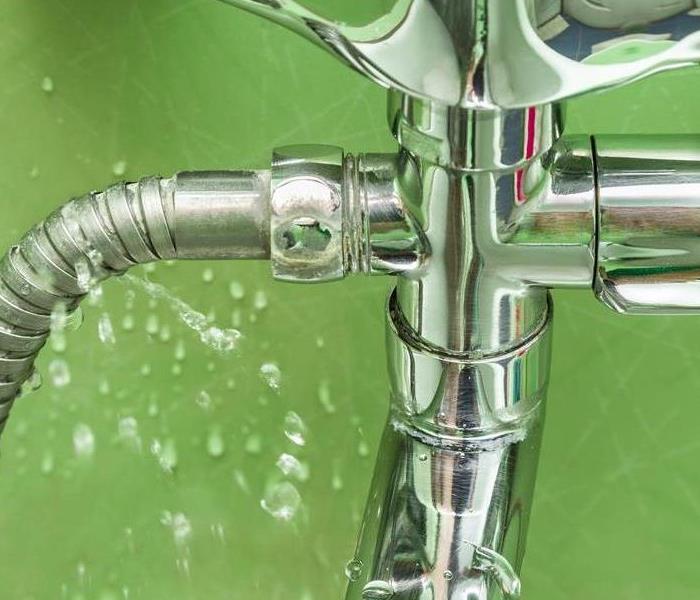 The key to protecting your home in Vancouver, WA, from a shower or bathtub leak is to act fast.
The key to protecting your home in Vancouver, WA, from a shower or bathtub leak is to act fast.
You find a wet ceiling on the first floor of your home in Vancouver, WA. It is below the bathroom. How do you know if it a shower or bathtub leak? Review the following tips to find out where the leak is coming from and what to do next.
Shower Pan Problems
A shower pan leak is a common reason for finding water on the ceiling below your bathroom. What is a shower pan and why would it leak?
• A shower pan is a waterproof barricade located between the subfloor and shower tile. It catches water that leaks below the tile and funnels it into the drain. It is typically made from vinyl or lead and can deteriorate as it ages.
• If there is a shower pan leak, common indicators include separation between the bathroom wall and floor and missing grout or mold on the shower floor. The telltale sign is water on the ceiling or space directly below your shower.
First Floor Showers
When you have a shower pan leak, the key is to act immediately when you notice a wet ceiling below the bathroom. But, what happens when your shower is on the first floor and you do not have a basement? How can you tell if a shower or bathtub leak is an issue then?
• If you have a crawlspace, check the ceiling down there every once in a while for water damage. Some indications of a serious problem include black, wet wood and hanging stalactites that resemble icicles.
• For houses on a concrete slab, water from a leaky shower travels along the floors or walls of nearby areas. Be vigilant looking for wetness that does not result from an obvious spill.
The key to protecting your home in Vancouver, WA, from a shower or bathtub leak is to act fast. Heed the above signs that indicate a shower pan problem. If you suspect mold or rot from water damage, contact a water restoration specialist as soon as possible to obtain a thorough inspection and recommendations for next steps.
For more information, visit http://www.SERVPROevancouverclarkco.com/.
Hidden Water
5/31/2018 (Permalink)
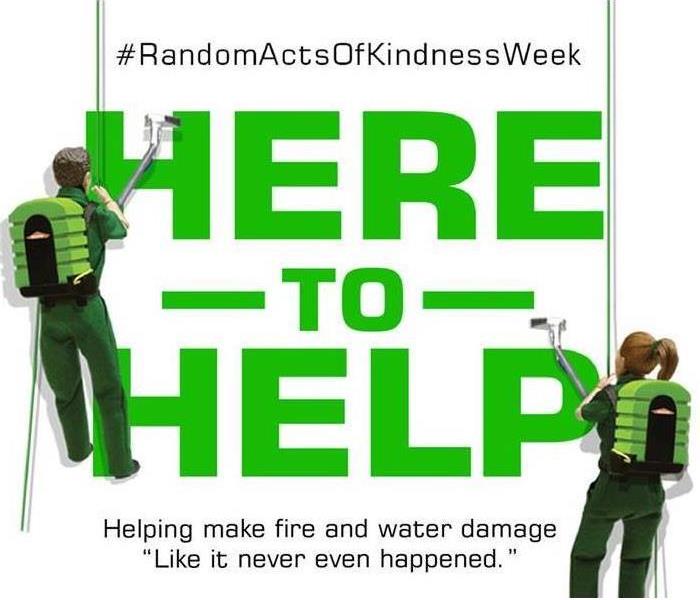 We're Here to Help.
We're Here to Help.
It's the water that you don't see after a leak that causes the most problems. It could contain bacteria, mold and other unseen damage. Before you risk further damaging the value of your facility or home by attempting to independently clean up the mess, call the SERVPRO professionals to ensure all aspects of your water damage are addressed properly. ensuring that further damage is not caused from hesitating to take action. SERVPRO professionals are trained to clean and restore your facility or home by identifying the water source, measuring the temperature and humidity for drying analysis, surveying the extent of the damage, performing emergency extractions, applying necessary treatments, utilize drying equipment and monitor drying, and disposing of all refuse.. We work closely with most all insurance carriers making the process run smoothly. "Like it never even happened."
Please call SERVPRO of E. Vancouver/Clark Co. as soon as possible 360-254-0049 for 24 hours a day 7 days a week service and response.
How To Salvage Wet Documents
4/23/2018 (Permalink)
Paper and ink, the two main components of a precious document, weren’t made to hold up in damp, wet, and waterlogged conditions. Ink dissolves and paper deteriorates quickly, so timely intervention is of the essence to prevent fragile wet documents from being lost forever. Taking action sooner rather than later by contracting a document restoration professional to do document drying is often a sound and wise decision.
Document-Saving Innovations to the Rescue
State-of-the-art vacuum freeze-drying technology can stop the progression of and prevent further damage by flash freezing the wet documents and then causing the frozen water to evaporate away without ever reverting to a liquid state. This same technology is used by The Library of Congress to dry and preserve historic artifacts and has National Archives and Records Administration and General Services Administration official approval.
Purifying gamma irradiation techniques can cleanse, sanitize, and deodorize articles such as files, papers, and blueprints that have been exposed to flooding or a sewage overflow incident in Vancouver, WA. Gamma radiation is often an excellent option because it can sterilize documents without heating or leaving behind a chemical residue.
Converting items into digital format helps ensure they are readily available and easily accessed when needed, helping make certain they’ll not be lost forever. These are common items that can be converted:
• Papers
• Manuscripts
• Maps
• Photos
Privacy Protection for Sensitive Documents
Around-the-clock surveillance in a Document Restoration Facility can keep sensitive documents safe and secure. Generally, documents are handled and managed by HIPAA Master-Certified technicians who understand the importance of maintaining proper chain of custody and privacy standards for sensitive documents.
Drying, Decontamination, Deodorization, and Digitization
Spreading wet documents out on the floor and waiting for nature to evaporate the liquid is usually not a viable solution if paper files are to be wrinkle, ripple, tear, mold, and contaminant-free. Highly trained document restoration professionals can expertly handle drying services in Vancouver, WA, from the smallest Mom-and-Pop business to the largest commercial conglomerate. They often have in-depth understanding of the document-drying process and genuine concern for the serious nature of the situation.
For more information, please visit us athttp://www.SERVPROevancouverclarkco.com/.
2 Ways To Determine If Your Carpet Needs Replacing
3/27/2018 (Permalink)
While there are a variety of things running through your mind after a pipe break or other situation has occurred in your home in Camas, WA, dealing with the aftermath means taking quick and decisive action to save your furnishings. After all, restoration should be handled by professionals, and the faster they can stop the spread of damage across your carpet, the better. Here’s how to determine the extent of the problem and whether your flooring is going to need replacing.
1. Consider the amount of time that’s passed.
If the water damage incident occurred within the last 24 hours, it can generally be handled fast enough for your flooring to be saved. A few fans set up around the room and opening the windows can help speed along the drying process until professionals arrive. Furthermore, if the mess was a result of a regular ground pipe break or a broken supply line running to your sink or dishwasher, your home’s rugs or flooring can often be cleaned quickly and efficiently. However, once that time period has passed or the water is deemed to be from a hazardous source, the possibility of restoring your floor becomes less likely.
2. Seek out the source of the water.
A situation involving a clean water source, as described above, can generally be considered a non-hazardous zone when it comes to water damage. However, if a sewage line breaks or the damage was caused by an environmental flood, your carpet has been compromised due to bacteria, viruses, fungi and potential diseases. This result calls for professional help and often means your flooring isn’t going to be salvageable.
Whether you’re dealing with a pipe break or other causes of water damage, it’s always best to call on professionals to help recover your home’s furnishings in Camas, WA. When you’re looking for clarification regarding the restoration of your flooring, follow these helpful tips to gain a better understanding of the situation and proceed from there.
Protect your Property this Winter
2/20/2018 (Permalink)
Freezing temperatures and winter weather can cause damage to your home and business if you aren’t properly protected. Freezing rain, high speed winds, sleet and snow can all cause costly damages to your home and business. We understand you can’t control the weather but you can take measures that will prepare you so you won’t feel the bite from the frost.
- Check your property for downed tree limbs and branches. Weather such as wind, heavy rain, ice and snow can cause branches to fall, which could cause damage to property and potentially cause personal injuries.
- Roofs, water pipes and gutters should all be inspected they are in proper order. Gutter downspouts should be directed away from your building. Clear gutters of debris that may have gathered during the fall. Leaves and other obstructions can lead to a damming effect, causing roof damage and interior water problems.
- Clean chimneys and exhaust systems to ensure they are free of debris.
- Test gas lines if they have been dormant to ensure they are in good working order with no leaks.
- Inspect your property, especially walkways and parking lots, for proper drainage to alleviate flood hazard potential.
- Protect pipes from freezing by allowing water to drip when temperatures dip below freezing. If pipes are under a cabinet, leave the cabinet doors open allowing warm inside air to circulate around the pipes. Make sure all exterior pipes are properly insulated.
- If the building has outdoor faucets, consider shutting water off at the main valve in the basement or crawl space. Once the valve is off, open the outdoor faucet to ensure it drains, preventing any remaining water from freezing in the pipe.
- Make sure all of your exterior doors, garages, roll-ups and windows have sufficient weather stripping.
- Ask your local SERVPRO franchise professionals about completing an emergency READY profile (ERP) for your business. The ERP is a no cost assessment to your facility, and provides you with a plan to get back in business fast following a disaster.
Water Damage Caused by Ice Dams
9/27/2017 (Permalink)
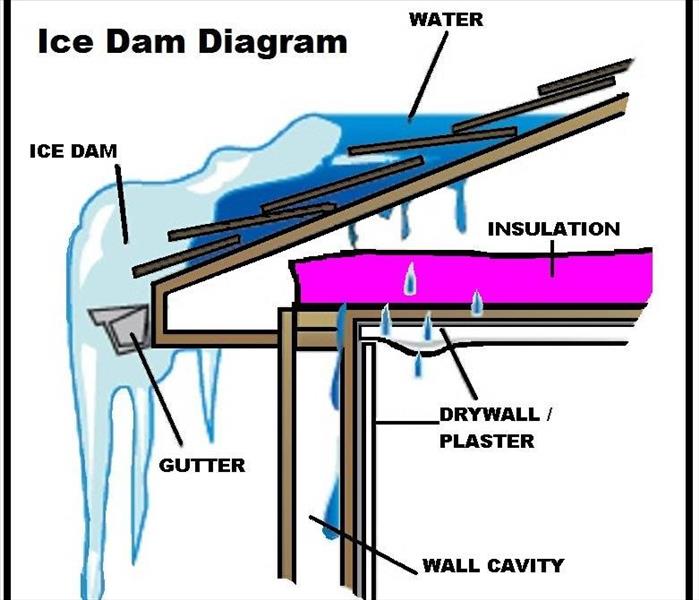 If you encounter water damage this winter pick up the phone and call SERVPRO of Vancouver 24/7 365 days a year! (360) 254-0049.
If you encounter water damage this winter pick up the phone and call SERVPRO of Vancouver 24/7 365 days a year! (360) 254-0049.
An Ice Dam is a hump of ice that forms at the edge of a roof under certain wintertime conditions. An ice dam can damage both your roof and the inside of your home. It will put gutters and downspouts at risk too.
There are several things you can do to avoid getting an ice dam or to reduce the risk of damage after one has formed, but there’s really only one cure: a combination of better sealing, insulation, and venting in the attic and eaves.
HOW DO ICE DAMS FORM?
An ice dam forms when the roof over the attic gets warm enough to melt the underside of the layer of snow on the roof. The water trickles down between the layer of snow and the shingles until it reaches the eave of the roof, which stays cold because it extends beyond the side of the house. There, the water freezes, gradually growing into a mound of ice.
The flatter the pitch of the roof, the easier it is for an ice dam to get a grip. Gutters at the eaves can also trap snow and ice. If snow and ice build up high enough in the gutter, it can provide a foundation for an ice dam.
WHAT DAMAGE DO ICE DAMS CAUSE?
When an ice dam gets big enough, melted water backs up behind it and seeps underneath the shingles. Eventually, it will drip into the insulation and down into the ceilings and exterior walls beneath the eave, ruining sheetrock and paint. If the ice dam breaks free, it can pull shingles and gutters off with it, and it will damage anything it falls on: shrubs, windowsills, cars, pets, and people. If the roof sheathing stays wet, it can form mildew and start to rot.
HOW CAN YOU DEAL WITH AN ICE DAM?
There are two avenues of attack: dealing with an existing ice dam and preventing one in the first place.
DEALING WITH EXISTING ICE DAMS
1. Remove the ice dam by breaking it free in small chucks. Do NOT use an ax or other sharp tool! You’ll cut through the shingles. Instead, tap lightly with a blunt mallet. This is slow, dangerous work, so hire someone experienced at roofing. Even if you do it safely, the chunks of ice can take pieces of shingle with them.
2. Clear out gutters and downspouts. Again, this is ladder work and an easy way to damage either plastic or metal gutters and spouts.
3. Melt troughs through the ice dam with calcium chloride ice melter. Do NOT use rock salt! It will damage paint, metals, and plants beneath the eave and wherever the salty water drains.
A good trough-maker is a tube of cloth (a leg from an old pair of panty hose works well). Fill it with calcium chloride, tie off the top, and lay it vertically across the ice dam. It will slowly melt its way down through the dam, clearing a path for the underlying water to flow free.
PREVENTING ICE DAMS
You can scrape snow from the roof whenever it falls, using a snow rake from below or a broom or plastic shovel from above. BE CAREFUL: The first method can bury you in snow, while the second can send you slipping off the roof. Hire someone who knows how to use a safety line.
You can replace your shingle roof with standing seam or other metal roof. Or you can replace the bottom three feet or so of your shingle roof with a wide metal drip edge. Whatever you do, install a water-repellent membrane under any new roofing.
NOTE: If your roof is not very steep, an ice dam can still form on metal roofing and drip edges.
THE CURE
All of these methods treat the symptoms, not the underlying problem, which is the warm roof, caused by poor insulation and venting of the space under the roof. We have found that the only way to cure an ice dam – and prevent one in the first place – is to:
1. Seal all points where warm air leaks from the living space into the spaces immediately below the roof sheathing.
2. Insulate the living space well enough to prevent conduction and convection of heat through the ceiling.
3. Vent the space between the insulation and the roof sheathing, so any heat that does leak through is carried away.
Home Vacation Preparation Checklist
8/2/2017 (Permalink)
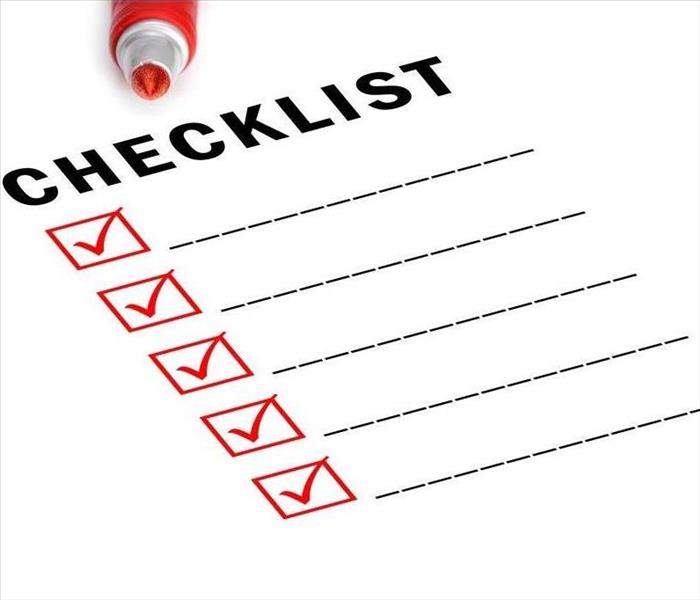 If you come home to water or fire damage pick up the phone and call SERVPRO of East Vancouver / Clark Co. @ (360) 255-0049
If you come home to water or fire damage pick up the phone and call SERVPRO of East Vancouver / Clark Co. @ (360) 255-0049
Your vacation should be relaxing and worry-free. That’s why it’s a good idea to prepare your home before you leave on any long trip. Then, any problems on the home front are just one less thing to worry about.
Make your house look lived-in
An empty house is like an open invitation to burglars. To keep your house looking occupied:
- Stop the newspaper and mail – or ask a trusted neighbor to pick them up
- Park your car inside the garage, if you have one
- Ask a neighbor to park in your driveway occasionally so there’s activity at your house
- Put at least one light in your house on a timer
- Install a motion-activated sensor on an outdoor floodlight. (Burglars hate outdoor lighting – and that’s why we love it)
- Make sure your lawn stays trimmed
Take the necessary plumbing and electrical precautions
Running appliances while you’re away is not only a needless expense, it could also lead to costly problems. To avoid the possibility of an appliance breakdown while you're away:
- Unplug small appliances and electronic devices
- Put the water heater in “vacation” mode
- Turn off water valves to the dishwasher, washing machine and all sinks
- Set your thermostat to a temperature closer to outside temps (warmer in the summer, cooler in the winter) but which still protects your plants, pets and furniture
General home preparation
Other things to consider doing before your vacation:
- Notify your credit card company and home security company that you’ll be out of town
- Make sure your smoke detectors are working properly
- Leave your emergency contact information with a neighbor
- Dispose of any food that could go bad before you return from vacation
- Take out the kitchen trash – especially anything that might start to stink
- Run your garbage disposal with a half-cup of vinegar and some water
Following this home preparation checklist before you leave for your vacation could save you a headache later. If you come home to water or fire damage pick up the phone and call SERVPRO of East Vancouver / Clark Co. @ (360) 255-0049
This article is compliments of Nationwide Insurance and be found here.
Why Hire Your Local SERVPRO Professionals
6/26/2017 (Permalink)
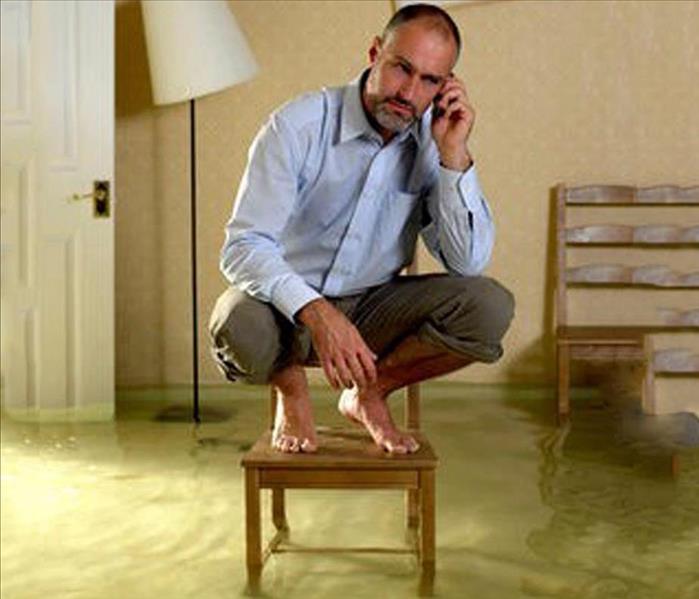 Please reach out to us with questions or concerns 24/7 365 days a year (360) 254-0049
Please reach out to us with questions or concerns 24/7 365 days a year (360) 254-0049
Water damage can happen to your home or business when you least expect it. Sometimes it may be as a result of leakages that you have been ignoring, or it can be an aftermath of a fire or flooding. Therefore, it might find you when you are not prepared financially to hire external help. So the first thing that will come to your mind is how to fix the water damage on your own to save money. You can do a very good job at dealing with water damage in your home in some situations, but if the damage is too severe, you will need the input of well-trained SERVPRO professionals to fix it for you. Here are the reasons why hiring professionals to do the work is the most prudent thing to do;
Once on site, professionals can quickly determine what items have been severely ruined by water damage. They will begin by getting rid of any porous items that could have come into contact with water because they tend to absorb too much water which can act as breeding grounds for harmful microbes. These items include mattresses, particle board, box springs, and pillows.
SERVPRO professionals will also identify any pockets that are holding excess moisture and remove the water. They have special equipment that they can use to measure moisture in hidden areas such as beneath tiles and other materials that do not become wet easily. When they find the hidden pockets, they will expose them to air by taking out the tile or material above it. They will also clean all areas with moisture using methods such as pressure washing with strong detergents. They will also accelerate the process of drying to prevent mold growth or any harmful bacteria. If the SERVPRO professionals discover the presence of bacteria or mold in your house, they will use mechanical or chemical methods to eradicate it.
At SERVPRO of E. Vancouver / Clark Co., we have experienced professionals who can spot compromised areas in your house and do everything possible to restore it. They are IICRC certified through a recognized organization.
Please reach out to us with questions or concerns 24/7 365 days a year (360) 254-0049
Understanding Water Classifications
5/30/2017 (Permalink)
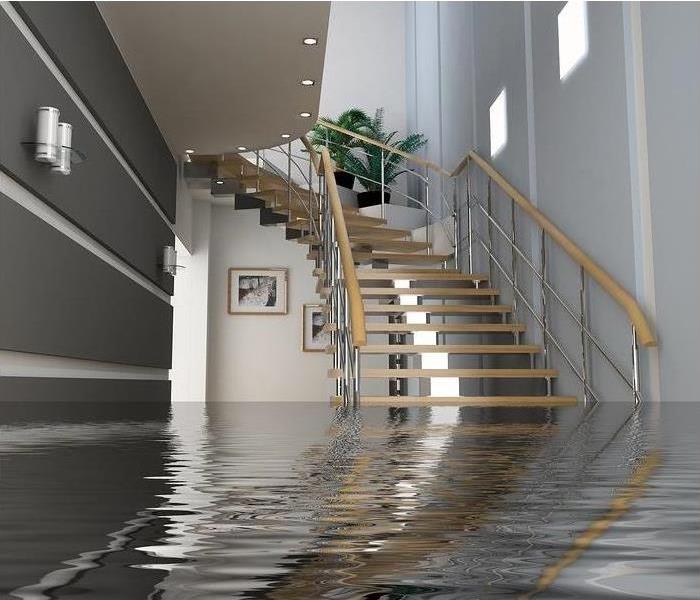 Sewage backup should be considered an emergency and dealt with as quickly as possible. Call us today @ (360) 254-0049
Sewage backup should be considered an emergency and dealt with as quickly as possible. Call us today @ (360) 254-0049
There are three major types of contaminated water. SERVPRO of E. Vancouver / Clark Co. will inspect that contaminated water to determine the type of water and then plan the appropriate response to safely restore your home or business.
The three types of contaminated water:
Category 1: "Clean Water"
This is water from a clean source, such as a broken clean water supply line or faucet. If left untreated, category 1 water can quickly degrade into category 2 or 3 water depending upon such factors as time, temperature, and contact with contaminants.
- Water from a clean source like a broken water line
- If left untreated, can degrade into category 2 or 3
Category 2: "Gray Water"
This water has a significant level of contamination that could cause discomfort or illness if ingested. Sources for category 2 water may include washing machine overflow; toilet overflow with some urine, but no feces; or dishwasher overflow.
- May contain bacteria and viruses
- Can quickly degrade into category 3 if left untreated
Category 3: "Black Water"
This water is grossly unsanitary and could cause severe illness or death if ingested, and any contact should be avoided. Sources for category 3 water could include flooding from rivers or streams, water from beyond the toilet trap, water from the toilet bowl with feces, or standing water that has begun to support microbial growth.
- May contain untreated sewage, harsh chemicals, and microbes
- Water from flooding rivers or sewer backup
Water Damage Prevention
4/21/2017 (Permalink)
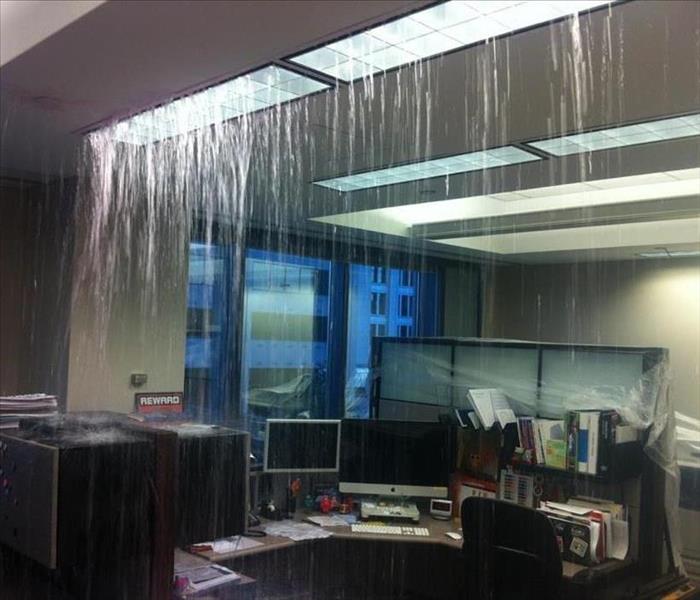 We can help! Call SERVPRO of Vancouver & Clark Co. today! (360) 254-0049
We can help! Call SERVPRO of Vancouver & Clark Co. today! (360) 254-0049
Burst Pipes in the water system is one of the most common plumbing problems both in the home and the public system. Several things can cause Burst Pipes, the main one been freezing conditions.
The pipe can be put under a great pressure through the system and any fault in the piping will be exposed over time and broken down. The effects of burst pipes can be dramatic and devastating all at the same time. A burst pipe on the main system can cause damage to property, put people out of homes and even close an entire area of a town and roads for a number of days. This can leave people without water and even homes for days.
We have integrated such complicated plumbing systems in our homes such as waste disposals, boilers and even garden features. Burst pipes within the home is simply the worst thing that can happen to your plumbing system. It is not the cost of the repair of the pipe or even the loss of the water whilst it is fixed, but the sheer amount and cost of the damage water can do.
If a pipe bursts in the ceiling or floor it can be some time before you notice and all too often the first you know is when the bulge appears or the water flows in a torrent.
The potential water loss from burst pipes in your house can be as much as 400 litres, that’s 2 full baths an hour. This means if you were away for a full day you could have up to 9,600 litres of water or 48 full baths of water in your house from burst pipes. If you were away for the week you could lose 47,200 litres of water in that week. The amount of litres lost is the equivalent to 336 full baths of water running through your house.
Prevention of Burst Pipes
Burst pipes can be devastating, so anything you can do to minimise the risk of a Burst Pipe happening in your home. As with most systems and parts of your home prevention is by far the best solution, below we have highlighted several key things you can do to.
- Ensure that any outside taps and piping including drain pipes for heating or overflow pipes are insulated. You can use insulating lagging or foam to do this but make sure you do not leave any joints, bends or taps exposed. For outside taps fitted covers are available.
- Any piping that are in unheated areas such as lofts, basements and garages all need to be lagged with good quality pipe lagging.
- Any pipes buried in the ground outside such as pipes to garages or sheds need to be buried deep enough and/or lagged.
- Insulate your cold water tank, this is so often forgotten and can be the major cause of Burst Pipes.
- Leave your heating on at least 54 degrees Fahrenheit at all times throughout cold spells. This will keep the system warm enough not to Burst Pipes and the water flowing.
- Fix any dripping taps or existing leaks before the cold spell. Many Burst Pipes happen because of leaks.
- Have your Central Heating System serviced regularly.
- In particularly cold spells leave the loft hatch open as this will allow the warm air to circulate around the loft space and warms any pipes in that space, reducing the risk of a Burst Pipe.
If you do occur a water leak in your home or business call SERVPRO of Vancouver & Clark Co. immediately! (360) 254-0049
 For all your Vancouver water restoration needs call SERVPRO of Vancouver East-West Clark County (360) 254-0049
For all your Vancouver water restoration needs call SERVPRO of Vancouver East-West Clark County (360) 254-0049






 24/7 Emergency Service
24/7 Emergency Service























